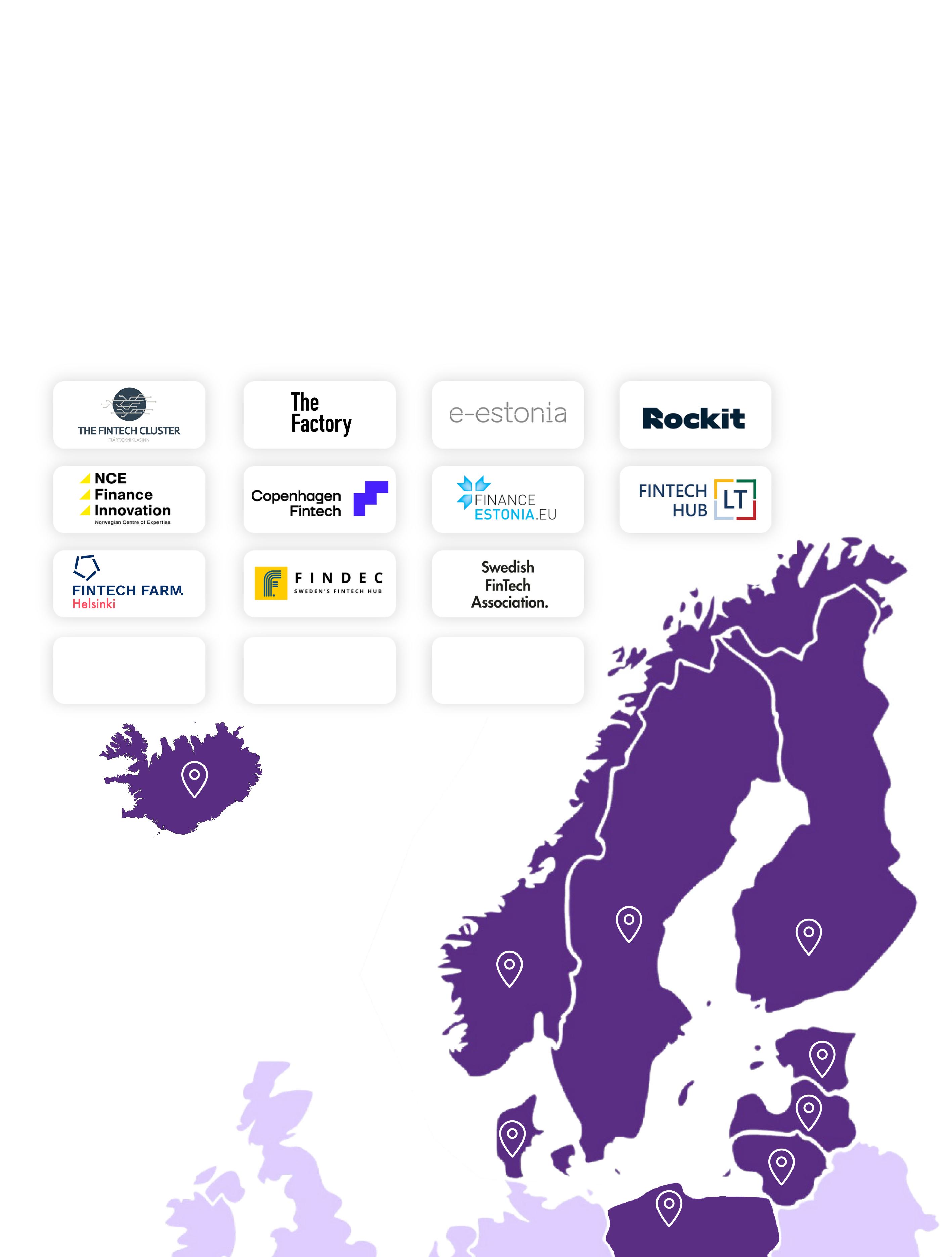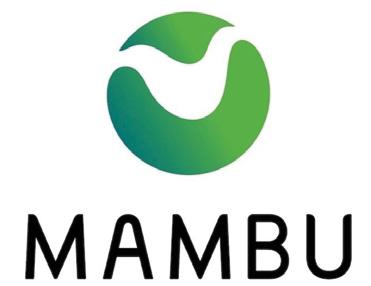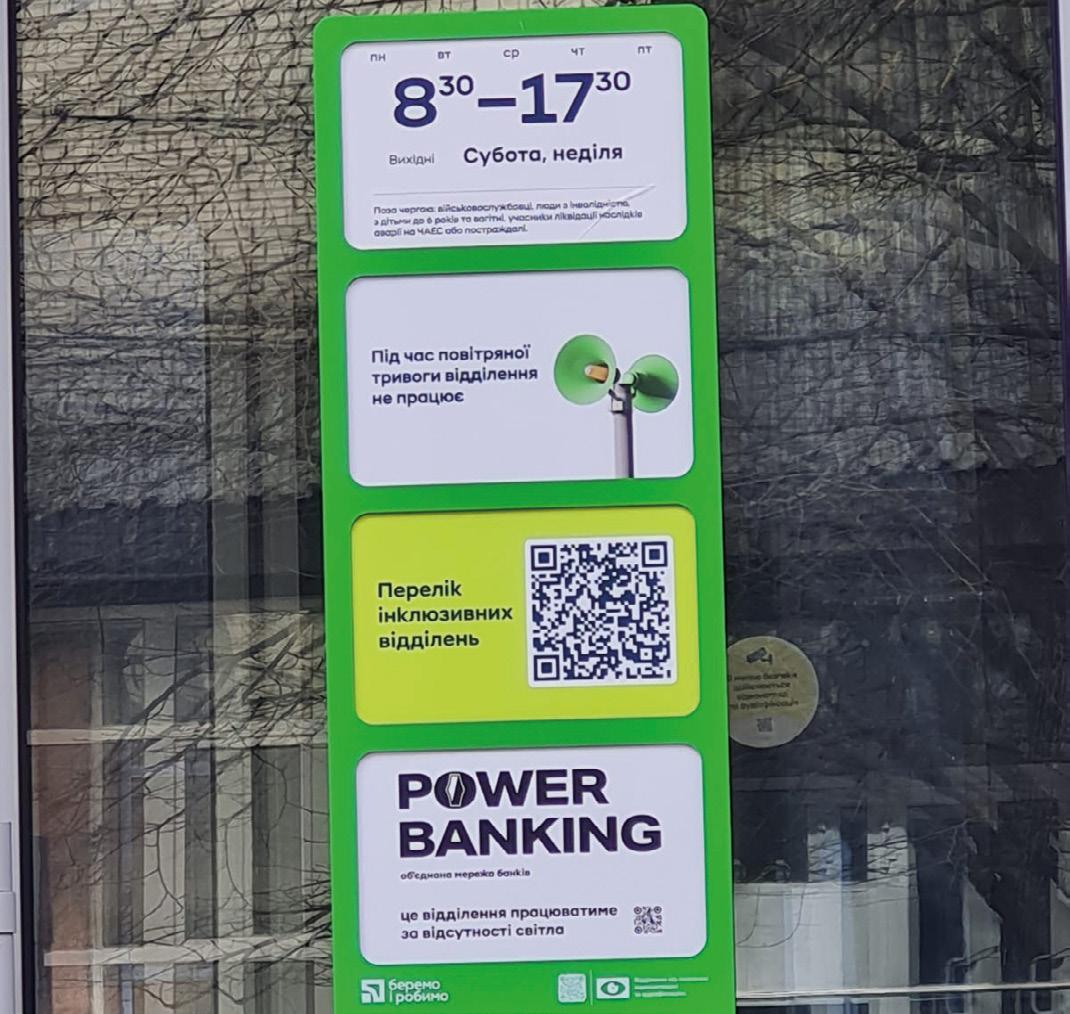




Nordic Fintech Magazine exclusively works together with selected Nordic Community Partners for insights and distribution, giving us unparalleled reach with audiences across the Nordics and Baltics







Thank you to all the fintech heroes contributing to this magazine!


























Welcome to the spring Edition of Nordic Fintech Magazine! p. 6-7
8-9

10-11
The Future of Finance Belongs to AI That Can Think and Act
The Growth and Future of Latvia’s Fintech Ecosystem: A New Era of Innovation and Collaboration

How the Baltics are Quietly Changing Global Financial Services
Resilience is Your Next Competitive Edge
Global Wallet AstroPay Opens Copenhagen Hub for European Expansion
Transforming Finance: Payhawk’s Impact on the Baltics and Beyond

Lithuania’s Fintech Ecosystem: A Model of Public-Private Synergy Driving Global Expansion
MAGNETIQ BANK: setting the standard of future B2B banking
ZTL Simplified B2B Payments in the Nordics. Now, It’s Ready to Scale.
Introducing automation in Fintech companies 5 key steps


40
From Startups to Success: Legal Support in the Baltic Fintech Revolution
CRIF Helps Fintechs and Banks Handle Data Overload
How MySQL is Transforming Financial Services
Beyond Quantum Computing: How Quantum Technology is Transforming Financial Services

The Evolution of Core Banking Is Underway
Lithuania’s Fintech Rise and Tribe Payments’ Role
DECTA Launches FinTech Fast-Track for New Acquirers and Issuers
The Customer Experience Problem Financial Institutions Don’t Want to Talk About

Your Data, Evolving with AI Right Now
Fimento Launches Self-Service AI Model for Transaction Categorisation
Why Flexibility, Speed, and Trust Matter More Than Ever in Business Banking
Introducing Hybrid Payments - On The Verge Of Digital Dominance

Stablecoins: The Silent Revolution Transforming Financial Services (And Why They’re Overtaking CBDCs) A Fintech PR Playbook to build credibility and get media coverage
Green Finance Institute Leads Lithuania-Based Fintechs Through the Regulatory Labyrinth

Fintechs to Watch
It started with a simple mission: serve the Nordic markets. That was always the goal for Nordic FinTech Magazine. We wanted to tell the stories of the innovators, the disruptors, the people shaping the future of finance in the region. But what we didn’t expect, what truly surprised us, was how quickly our focus expanded.
By Chris Crespo

The moment we took a closer look at each of the five Nordic markets, we saw something incredible. Each country had its own distinct approach to fintech, its own way of pushing the boundaries of digital finance. That diversity fascinated us. But then came the invitation, an open door to explore the Baltics, and we walked through it.
From that moment, we were hooked.
The Baltics are different. There’s a spirit here, an energy, a drive that’s impossible to ignore. Maybe it’s rooted in history, in the resilience that at the fall of the Soviet Union brought together 2 million people in the Baltic Way, A human chain, showing solidarity in protest against Soviet occupation, spanning the geogrpahies of all three countries. It’s message was deafening: ‘We want to be free, sovereign and independent”. Maybe it’s the deep-seated belief in innovation and ownership. Whatever it is, it’s working. Today, the region is home to a thriving fintech ecosystem with 676 companies employing thousands of talented fintech heroes across the region.
These numbers tell a compelling story. The Baltic fintech sector is growing, creating jobs, and positioning itself as a major player in the global financial sector. It’s not just about the numbers, though. It’s about the impact these companies are making, not only in their home countries but aroudn the world.
Over the past three years, we’ve built strong connections here, and what stands out the most isn’t just the technical expertise, it’s the commitment to making a global impact. There’s a sense of brotherhood and sisterhood in how these economies develop, in how knowledge is shared, and in how different players in these ecosystems, both private and public, uplift one another.
That’s why we’re thrilled to be part of Baltic Fintech Days. Lithuania, Latvia and Estonia, are coming together to:
• Give Baltic fintech companies a stage to showcase their thought leadership.
• Brand the region as Europe’s next major fintech hub. Attract international investors and partners looking for cutting-edge collaborations.
The same spirit of freedom and liberation that surged through the Baltics 35 years ago is now emerging in Ukraine. Just as the Baltic nations turned hard-
Chris Crespo Head of Content at Nordic Fintech Magazine

ship into an opportunity for reinvention, Ukraine is proving that resilience breeds innovation. We had a unique opporutnity to speak to representatives from the Ukrainan Financial Ecosystem to gain an understanding of how war can impact a country’s financial system. During our conversations with six key representatives from the Ukrainian financial sector, including the National Bank of Ukraine, leading commercial banks, international institutions, and fintech pioneers, we learnt firsthand how they are navigating immense challenges. Even under extraordinary pressure, they are maintaining economic stability, adapting financial infrastructure, and pushing forward with innovation. Their efforts highlight the critical role fin-
tech and finance play in sustaining an economy during crisis and laying the groundwork for recovery.These are the stories that need to be told.
And that’s why this issue is so special. In addition, we’re tackling some of the most groundbreaking topics in fintech, not just in the Nordics and the Baltics, but globally. AI has exploded past even the boldest predictions, and we’re featuring insights on how it’s overhauling banking, making processes faster, smarter, and more efficient. We’re also breaking down stablecoins and how they’re reshaping the very concept of money. We continue to explore the fascinating an perplexing world of quantum as the financial landscape is being is being supercharged with innovation
and unprecedented speed.
We also bring insights into the technologies that are transforming everything from how financial services organizations fight fraud to how they streamline operations, reduce waste, boost resilience, and create hyper-personalized customer experiences.
So, as you flip through these pages, we hope this issue sparks curiosity, challenges perspectives, and offers a deeper understanding of the dynamic forces at play in fintech today. Because whether it’s the Nordics, the Baltics, Ukraine or beyond, one thing is clear: the future of fintech is being rewritten, and we are honoured to have a front row seat.
Stay disruptive.
A few years ago, the idea of AI-powered financial advisors, fraud detection systems that operate independently, and hyper-personalized banking experiences felt more like science fiction than reality. Predictions suggested we wouldn’t see real progress in agentic AI until 2030. Yet here we are in 2025, and these AI-driven transformations are happening now, faster and more powerfully than anyone expected.
By Chris Crespo
Alfred Mukudu, Head of Go-to-Market Strategy & Business Development for Financial Services at AWS, has had a front-row seat to this shift.
“I’ve read forecasts where the assumption was we’d start getting to agentic AI around 2030, but already in 2025, we’re finding useful applications,” he says. AWS has been rolling out agent capabilities across industries, not just for developers but for real business and consumer-facing applications.
AI has already made waves in financial services, particularly behind the scenes.
Automation has improved fraud detection, streamlined customer service, and helped firms meet compliance requirements. But there’s a gap. Most AI implementations are passive, waiting for inputs rather than taking initiative.
“The difference with agentic AI,” Mukudu explains, “is that it’s not just answering questions. It’s actually doing things.”
Financial institutions are under pressure. Customers expect seamless, personalized interactions. Regulators demand airtight security and compliance. Fintech challengers are pushing the boundaries of automation.
Traditional AI models, as powerful as they are, still require too much human intervention. That’s where agentic AI changes the game.
It’s about giving financial institutions choice, whether it’s encryption, deployment strategies, or selecting the best large language model for their needs.
Alfred Mukudu Head of Go-to-Market Strategy & Business Development for Financial Services at AWS
Mukudu breaks it down simply:
“Think of agentic AI as an AI system that can independently perform tasks and make decisions. Unlike traditional generative AI, which responds to prompts but lacks the ability to take action, agentic AI can execute workflows autonomously.”
For example, today’s chatbots can tell you how much vacation time you have left. But an agentic AI system? It doesn’t just provide the information. It books your leave, finds flights, and even arranges transportation. This leap from passive AI to proactive automation is where financial services are heading.
One of the most compelling applications of agentic AI is hyper-personalization. Mukudu points to NatWest Bank in the UK as a prime example. “They enabled over two million people to save for the first time just by personalizing messaging at scale,” he says. Instead of sending out generic emails, NatWest uses AI to tailor financial guidance to each customer’s individual behaviors.
“We’re talking about true one-to-one personalization, where ten different customers get ten different messages based on what matters to them.”
To make agentic AI work at scale, Mukudu highlights three key ingredients:
1. Data Infrastructure. “You need access to a knowledge repository, whether it’s standard operating procedures, database access, or clean data,” Mukudu says. Without strong data management, AI agents can’t make informed decisions.
2. Actionable APIs and Microservices. AI has to be able to do more than just analyze data. “Microservices and good APIs are critical so these agents can execute tasks seamlessly,” Mukudu explains.
3. Governance and Upskilling. When AI is making decisions 24/7, you need the right oversight. Mukudu stresses that firms must train

Alfred Mukudu, Head of Go-to-Market Strategy & Business Development for Financial Services at AWS
their teams. “Agents rely on good prompt engineering, so upskilling employees is key to maximizing automation.”
AWS is actively shaping the future of agentic AI in finance. Mukudu describes the company’s approach.
“We’re democratizing access to these technologies. It’s about giving financial institutions choice, whether it’s encryption, deployment strategies, or selecting the best large language model for their needs.”
With platforms like AWS Bedrock (a fully managed service that simplifies building and scaling generative AI applications), a vast selection of compute instances, and purpose-built database services, AWS is ensuring that financial institutions can deploy AI in ways that suit their operational needs. “The ability to choose how you implement AI is going to be super
powerful,” Mukudu emphasizes.
Looking forward, Mukudu is particularly excited about AI’s expansion into edge computing. “With AWS Outposts, Local Zones, and Wavelength, we’re extending cloud capabilities closer to where customers are,” he says. AI running at the edge, on devices, in branches, and within networks, means faster decision-making and more seamless interactions.
Further down the line, emerging technologies like quantum computing and blockchain will push agentic AI even further. Mukudu is confident that these developments will “fundamentally transform how we interact with financial services.”
Agentic AI is no longer just a concept. It is happening now. From automating workflows to delivering hyper-personalized financial experiences, it is already transforming the industry. The firms that embrace it
today will be the leaders of tomorrow. Those who hesitate? They will be playing catch-up.
Mukudu sums it up with a clear message. “Agentic AI is not just about efficiency. It’s about rethinking how financial services interact with people, making every experience smarter, faster, and more personal.”
Amazon Web Services (AWS) is the world’s most comprehensive and broadly adopted cloud, with more than 200 fully featured services available from data centers globally.
Millions of customers—including the fastest-growing startups, largest enterprises, and leading government agencies—are using AWS to lower costs, increase security, become more agile, and innovate faster.
Latvia’s fintech ecosystem stands at the cusp of a transformative moment. The past year has been a crucial one for both the FinTech Latvia Association and the broader Latvian fintech sector. As we celebrate the launch of the third annual Fintech Pulse report (please check it online here: fla.lv/pulse2024), I am proud to reflect on our many achievements and the exciting developments on the horizon.
By Tina Luse, Managing Director of the FinTech Latvia Association
With the momentum we’ve built, Latvia is not only cementing its position as a fintech hub but is also spearheading initiatives that are paving the way for a dynamic future of innovation, collaboration, and growth.
One of the most significant milestones this year has been the dramatic growth in our membership. The number of members within the FinTech Latvia Association has doubled, reflecting the expanding scope and diversity of Latvia’s fintech sector. We have welcomed new members from across the financial technology spectrum: established digital lending platforms, prestigious law firms serving fintechs, and market leaders in business lending, crowdfunding, RegTech, and even a fully fintech-oriented bank. This growing diversity is a
testament to Latvia’s rising status as an integrated fintech destination. This rapid expansion underscores the increasing importance of Latvia as a hub for financial technology and innovation. More importantly, it highlights the value of our mission: to foster financial inclusion, democratize access to investment opportunities, and enhance financing options across various financial verticals. With this influx of new members, we are accelerating the development of a robust ecosystem capable of driving significant change both locally and globally.
A particularly noteworthy development within our growing membership is the collaboration among investment platforms within the Association. At the end of this year, these platforms came together to sign a memorandum aimed at shaping the future of regulated fintech. The memorandum calls for the unification of platforms to
create a more secure and transparent regulatory environment for alternative investment markets. The objective is to foster collaboration between fintech businesses, improve investor protection, and promote regulatory certainty. By working together, these platforms aim to advocate for responsible regulation that benefits both the industry and the wider public, ensuring that the sector continues to thrive and evolve in line with European standards.
This initiative aligns perfectly with our core mission at FinTech Latvia—ensuring that Latvia not only remains at the forefront of innovation but also leads the way in setting a global example of a well-regulated, transparent, and inclusive fintech landscape. Through this memorandum and similar efforts, we are confident that Latvia will continue to attract both investors and entrepreneurs, fostering an environment of trust and collaboration.

As a region, we are stronger together.
Tina Luse
Director
The importance of a strong regulatory environment cannot be overstated. This year, Latvia took significant steps forward with the successful passage of the national law for the MiCA (Markets in Crypto-Assets) regulation, a crucial milestone for the country’s fintech landscape. With this regulatory framework in place, Latvijas Banka—the Central Bank of Latvia—is now empowered to welcome new market participants with aspirations for pan-European expansion in the crypto space. Moreover, it has already been offering free pre-licensing consultations since mid-2024.
Latvia’s regulatory clarity and openness are increasingly being recognized as key factors that make the country an attractive location for fintech businesses. As I’ve repeatedly heard from companies,
“Working with Latvijas Banka feels like working with another fintech— just from the public sector.”
In addition to MiCA, Latvijas Banka continues to provide unparalleled support to fintech innovators through initiatives such as pre-licensing consultations, innovation sandboxes, and capped supervision fees for crypto service providers. These efforts ensure that companies entering the EU market can do so with ease and clarity, making Latvia a safe, competitive, and accessible jurisdiction for fintech entrepreneurs.
Among the most significant developments past year was the groundwork being laid for non-bank payment providers to gain access to the SEPA (Single Euro Payments Area) payment system via the Central Bank, which at the moment is already fully operational. This move signals Latvia’s commitment to ensuring that fintech companies have the tools and infrastructure they need to operate on an international scale.

In line with our growth, we have also deepened our international collaborations. For several years now, we have been proud members of the European Digital Finance Association (EDFA).
Since January 2021, Tīna leads the Fintech Latvia Association. The aim of the Association is to unite the providers of financial services of the non-banking sector based on financial technologies in order to ensure the representation and implementation of their interests at the national and international level, promoting sustainable development and growth of the Latvian financial sector.
This prestigious platform allows us to represent Latvia’s fintech interests on a pan-European stage, further amplifying our voice within the European Union and beyond. I am especially impressed about the ECSP crowdfunding platform working group operational under the umbrella of EDFA.
With our regional partners, we are also focused on how to enhance the visibility of the Baltics as a key player in the global fintech scene. A prime example of this regional collaboration is the Baltic Fintech Days — a unique event that will bring together the fintech ecosystems of Latvia, Estonia, and Lithuania. This event reflects our shared vision of creating a sustainable, competitive, and dynamic environment for financial technology in the region. By uniting the expertise and resources of all three countries, the Baltic Fintech Days will showcase innovations emerging from our ecosystems,
foster cross-border collaboration, and highlight the value of regional cooperation in advancing the fintech industry.
The Baltic Fintech Days will serve as a platform for thought leadership, knowledge-sharing, and business development across the Baltics and beyond. As a region, we are stronger together, and this event will highlight the collective potential of the Baltics as a global fintech powerhouse. Our goal is not only to showcase the fintech innovations emerging from our countries but also to provide a platform for startups, investors, and regulators to collaborate, exchange ideas, and shape the future of fintech in Europe. With a dynamic regulatory environment, a highly skilled workforce, and strong political support, the Baltics are quickly becoming one of the most sought-after regions for fintech entrepreneurs. See you in Vilnius on 2nd and 3rd of April, 2025!
Looking ahead, we recognize the importance of restoring Latvia’s reputation as a safe and competitive jurisdiction for financial services. This year, our ecosystem has been preparing for the upcoming Moneyval assessment, which evaluates anti-money laundering (AML) and counter-terrorism financing measures. This process ensures that Latvia remains a trusted environment for both investors and fintech companies, fostering sustainable growth and reinforcing our commitment to maintaining the highest standards of regulatory compliance.
But our ambitions don’t end there. With the guidance and leadership of Latvijas Banka and the support of the Prime Minister, we are actively shaping the next phase of Latvia’s fintech development strategy. Our vision is clear: to build a robust, sustainable, and inclusive fintech ecosystem that attracts talent, fosters innovation, and provides ample opportunities for all stakeholders.
We invite new players—whether they are entrepreneurs, investors, or innovators—to join us on this exciting journey. Together, we can build a future where Latvia not only thrives as a fintech hub but also serves as a model for other nations striving to create dynamic and sustainable financial ecosystems.
Join us, and you could be the next success story in this thriving community!
A decade ago, if you had asked most people to name the world’s leading hubs for fintech innovation, you would have heard answers like Silicon Valley, London, or Singapore. But today, there’s another name that’s impossible to ignore: the Baltics. Lithuania, Latvia, and Estonia have quietly built one of the most vibrant fintech ecosystems in the world, revolutionizing the way payments work.
By Chris Crespo

Juha Sillanpää, Group Country Manager, Finland and Baltics at Visa, sees the region as a “hotbed of payments innovation” and an example for the rest of the world. So what makes the Baltics so special? And what can other markets learn from this rising fintech force?
Why the Baltics Stand Out Walk into a café in Vilnius, and you’ll likely find people tapping their phones to pay without thinking twice. Digital payments are second nature here, thanks to a highly educated and tech-savvy population. This has created the perfect environment for fintech solutions to take off at lightning speed.
But it’s not just about the people, it’s also about policy. “The Baltics have created a unique environment where fintech startups thrive,” says Juha. The Baltics have a regulatory system that actively encourages innovation. Instead of stifling fintech startups with bureaucracy, governments and central banks
have taken a forward-thinking approach, making it easier for companies to test, refine, and scale new payment solutions.
And let’s talk about the startups. The Baltics have become a launchpad for globally recognized fintechs. With government-backed incubators, an influx of venture capital, and a strong talent pool, the region’s fintech ecosystem is booming. Companies are scaling fast, setting trends that the rest of the world is watching closely.
Lessons from Baltic Innovation
Imagine sending money to a friend and having it land in their account instantly. That’s already a reality in the Baltics. Real-time payments are the norm, setting a high standard for markets still struggling with slow bank transfers.
Then there’s Estonia’s e-residency program, which has completely changed the way business is done. Entrepreneurs from anywhere in the world can establish and run a company digitally, with secure online transactions
backed by a robust digital identity system. This approach is shaping the future of global business operations.
The Baltics have fully embraced blockchain technology, using it for everything from financial transactions to secure digital contracts, driving transparency and efficiency.
Unlike other regions where regulation can feel like a roadblock, the Baltics use regulatory sandboxes to their advantage. These controlled environments allow fintechs to test their products in real-world conditions while ensuring compliance. It’s a win-win for both innovation and consumer protection.
“Innovation thrives in environments where businesses can test, learn, and iterate quickly. The Baltics have nailed this approach,” says Juha.
New Players: Threat or Opportunity?
“With fintechs popping up left and right, you might expect Visa to see them as competition. But that’s not the case” affirms Juha. Many of these newcomers
Juha Sillanpää
Group Country Manager, Finland and Baltics at Visa
bring fresh perspectives, contributing to the overall evolution of payments. In fact, many of them end up becoming valuable partners, enhancing Visa’s services and improving the payment experience for everyone.
“Of course, competition is real. But rather than resisting change, Visa embraces it” he adds. The pressure from new entrants keeps everyone on their toes, driving continuous innovation and better solutions for businesses and consumers alike.
“At Visa, we don’t see fintechs as threats. We see them as partners who can help drive the industry forward,” says Juha.
Visa has a history of engaging with fintech startups, understanding that fostering innovation helps drive industry progress. By providing funding, expertise, and access to a global network, Visa ensures that the most promising ideas don’t just stay ideas, but that they become reality.
“Think of Visa as the backbone of fintech innovation” says Juha. Its suite of APIs makes it easy for startups to integrate payment processing, fraud prevention, and other critical services, allowing them to focus on what they do best, innovating.
Scaling globally is a major challenge for startups, but Visa removes that barrier with its vast infrastructure, enabling fintechs to expand beyond their home markets and reach customers worldwide with seamless payment options. At the same time, navigating regulations can be complex, but Visa’s deep expertise in security and compliance helps startups stay ahead of regulatory requirements while protecting them from fraud and cyber threats. “Our role extends beyond payments, focusing on enabling innovation,” says Juha.
And for those just getting started, Visa’s Fintech Fast Track Program offers crucial support to startups looking to navigate the complexities of scaling and regulation. It provides funding, mentorship, and strategic partnerships, helping fintechs accelerate their growth and bring their solutions to market faster.
As payments speed up, so do fraud risks, requiring constant innovation to stay ahead of cybercriminals. Visa employs over 1 000 full time cybersecurity specialists globally and operates 3 Cybersecurity Fusion Centres on three
Innovation thrives in environments where businesses can test, learn, and iterate quickly. The Baltics have nailed this approach.
Juha Sillanpää
Group Country Manager, Finland and Baltics at Visa
different continents to ensure that the network operates every day of the year.
Just over the past five years, Visa has invested over €11 billion in technology, including to reduce fraud and to enhance network security.
“Last year, Visa proactively prevented an estimated EUR 39 billion in global fraud, contributing to our network’s fraud rates being among the lowest rates of any payment method. However, I strongly and personally believe that in order to successfully combat fraud, we need ensure that we as an industry collaborate closely to stay ahead of the cybercriminals,” Juha Sillanpää adds.
At the same time, financial inclusion remains a challenge, with millions still lacking access to digital payments. Ensuring fintech solutions reach underserved communities is essential for broader economic participation.
Cross-border transactions add another layer of complexity, as different financial networks don’t always integrate smoothly, creating friction in global payments. Meanwhile, the rise of digital currencies raises questions about how they fit into traditional finance while maintaining security and regulatory compliance. “The goal is not just faster payments but also smarter, safer, and more inclusive payments,” says Juha.
The Baltics have proven that size doesn’t matter when it comes to innovation. This small but mighty region is setting global benchmarks in payments, and companies like Visa are ensuring that the momentum doesn’t slow down. “The payments industry is evolving at lightning speed. The Baltics are at the forefront, and Visa is proud to be part of that journey,” says Juha.


In an era of digital banking and instant transactions, resilience in financial services has become a boardroom priority. Having launched full fintech infrastructures for financial services firms, I’ve seen first-hand how even minor disruptions erode customer trust and invite regulatory scrutiny.
By Ian Kalla, Head of Fintech at FinanceEstonia and Commercial Lead at XYB
The past year’s disruptions have hammered home a clear lesson: robust infrastructure and operational endurance are now essential for competitive advantage. In a market that prizes reliability, resilience is emerging as the next big differentiator.
Recent high-profile outages have exposed glaring resilience issues even in major banks. In early 2025, a third-party service failure left thousands of Capital One customers unable to access accounts or receive direct deposits. Over two dozen other financial institutions relying on this provider were affected. The same week, Barclays suffered a “technical glitch” that knocked out customers’ access to accounts for nearly 24 hours. The timing could not have been worse – it hit on January payday, leaving some people unable to pay bills or withdraw wages. In October 2024, a Bank of America outage saw online balances suddenly drop to $0 due to a widespread systems outage. Panicked account holders flooded support lines until the issue was resolved, illustrating how quickly a technical hiccup can escalate into a consumer confidence crisis.
These incidents highlight common failure points: IT glitches, third-party dependencies, and operational missteps. The impacts – frozen transactions, reputational damage, and regulatory scrutiny – demonstrate the industry’s growing systemic risks. Reliance on a handful of critical IT providers means a single failure can ripple across institutions, raising concerns about financial stability. In other words, a single outage at a key tech partner – or a botched software update – can quickly become everyone’s problem. The wake-up call from these outages is loud and clear, and it has accelerated efforts to fortify operational resilience across the sector.
The Digital Operational Resilience Act (DORA), in effect since January 2025, aims to standardise resilience requirements across the financial sector. Covering banks, insurers, and investment firms, DORA enforces stricter ICT risk management, incident reporting, and resilience testing. This means banks and insurers now need to prove they can prevent, respond to, and recover from disruptions in a systematic way – no more ad-hoc fire-fighting or hoping vendors never fail. One of the biggest shifts under DORA

is how it elevates the treatment of third-party tech partners. Financial firms now must ensure that their software vendors, cloud providers, and other ICT suppliers adhere to the same high resilience standards. Importantly, DORA introduces an oversight framework whereby if a tech provider is deemed “critical” to the financial system, it can be directly supervised by EU regulators. This is a game-changer: major cloud and core banking service providers could find themselves under regulatory watch to ensure they don’t become single points of failure. In sum, DORA is forcing a culture change: operational resilience is moving from box-ticking compliance to a strategic priority
Ian
Kalla, Head of Fintech at FinanceEstonia and Commercial Lead at XYB

that’s jointly owned by financial institutions and their tech partners.
The Role of Fintech Enablers
The next generation of financial services will be defined not only by the features and rates on offer, but by the trust that comes from consistent uptime and crisis-proof operations.
Fintech enablers play a critical role in brewing resilience into their offerings. Next-generation banking platforms are increasingly built with failover capabilities, automated resilience testing, and modular architectures that allow financial institutions to recover rapidly from disruptions. For example, cloud-native core banking platforms now offer real-time redundancy, ensuring continuous service in case of outages. This minimises downtime risks compared to legacy infrastructure. Similarly, embedded resilience features
– such as automated incident reporting and built-in compliance tracking – help financial institutions meet regulatory requirements seamlessly.
Beyond raw infrastructure strength, fintech enablers are uniquely positioned to introduce resilience-oriented value propositions. For instance in XYB, we’ve positioned the platform as a way for banks to modernise their core systems with no risk and zero downtime. The component-based design lets banks upgrade piece by piece, rather than via risky “big bang” migrations. This approach directly addresses one historical cause of outages – the complexity of legacy cores – by enabling both component optionality as well as progressive
modernisation. Apart from that, we believe there’s plenty of room for further innovation around resiliency.
Collaboration for a Robust Financial Ecosystem
At the FinanceEstonia DORA seminar on January 17, industry leaders from legal, audit, banking, and technology sectors discussed how financial institutions can work with service providers to implement resilience-first strategies. The consensus? Resilience in financial services is a team sport. No single bank or provider can ensure stability alone – it requires coordination across the entire ecosystem.
Financial institutions must work closely with their technology vendors, cloud platforms, and fintech partners to identify single points of failure and design them out. This means jointly mapping out dependencies, sharing incident data, and coordinating on contingency plans. Likewise, fintech and tech providers need to proactively support their clients’ resilience goals –whether by adapting products to meet new compliance requirements or by participating in industry-wide drills and information-sharing schemes. When a critical outage hits, a well-coordinated response between a bank and its vendors can make the difference between a brief hiccup and a prolonged crisis.
As we look ahead, it’s clear that resilience is becoming an essential pillar of digital finance’s value proposition. Regulators have set the direction with DORA and similar rules, but it’s up to the industry to turn compliance into creativity. The next generation of financial services will be defined not only by the features and rates on offer, but by the trust that comes from consistent uptime and crisis-proof operations. Far from being a hindrance, the new resilience regime can become a driver of innovation.
Forward-looking firms see DORA not just as a compliance headache, but as an opportunity to streamline risk management and upgrade aging systems for the digital age. By embracing collaboration – banks working hand-in-hand with fintech enablers – we can build a financial ecosystem that doesn’t just survive disruptions but thrives through them. In that sense, resilience is more than a defensive strategy; it’s the new competitive edge that will separate the leaders from the laggards in the financial services arena.
In 2020, AstroPay was only a checkout solution - a button on a web page that allowed you to pay for items. Since bringing on new CEO Marc Sacal - whose extensive financial background includes co-founding Arcus, a payments company that raised over $20 million in VC funding before being acquired by Mastercard, as well as experience at Goldman Sachs—AstroPay has grown into a global wallet with millions of users worldwide.
By R. Paulo Delgado
The company’s vision is to make cross-border finance as easy as possible, with a particular focus on digital nomads and freelancers who work internationally.
“Our ultimate goal is to build a global bank where access to financial services isn’t limited by the currency you use or where you live. The world is becoming increasingly digital, and we’re ensuring banking keeps up,” says Sacal.
Copenhagen will be AstroPay’s European base Sacal strategically set his sights on Denmark, and specifically Copenhagen, for AstroPay’s European base because of the zone’s “global-first” approach and its ability to attract global talent.
“I lived in Copenhagen for a year, and the international community there is remarkable. Denmark’s compact size drives organic integration of people from all over the world, giving it an inherently global mindset and making it an ideal base for AstroPay,” he says.
When the World Bank ran its renowned Doing Business Report, Denmark consistently ranked as the
The future of banking must be global-first, real-time, and currencyagnostic, ensuring that work, travel, and finance move seamlessly across borders. AstroPay is building that future.
top easiest country to do business in, snatching the number one spot for nine consecutive years. The country is known for its highly innovative environment and strong infrastructure.
Investments in fintech are booming in Denmark, with Q1 2024 attracting more investments into fintech than the entirety of 2023. Despite the risk-averse attitude experienced globally in 2023 for fintech investment, Denmark still outperformed its two neighbours. Fin-
tech investment into Denmark in 2023 made up a total of 37.5% of all fintech investments in the Nordics for that year.
The number of people working in fintech experienced 6X growth between 2015 and 2022, making fintech even larger than the insurance industry.
During Sacal’s time in Copenhagen, he grew impressed by the combination of strong work ethic and international culture in the city. Denmark’s central positioning is also favorable, attracting the best talent from the Baltics, Northern Europe, and Scandinavia.
The Institute for Management Development (IMD), an independent academic institution from Switzerland, prepares a global talent ranking report each year. The report looks at Talent Competitiveness between 67 countries, based on 31 indicators and three categories. The categories include how much the country invests in talent development, how much appeal it has for overseas talent, and the degree of availability it has for competencies in the talent pool.
In its 2024 report, IMD ranked Denmark number five globally, beating Germany, the USA, and the EU average by far.
AstroPay also chose Denmark due


to its regulatory clarity and speed-tomarket advantages, which will help ensure compliance while quickly expanding financial services responsibly. The company has secured an EMI license in Denmark, enabling it to offer key financial services under strict regulatory oversight.
The EMI license allows AstroPay to operate within a well-defined framework, ensuring transparency and consumer protection. For services beyond the EMI’s scope, AstroPay will collaborate with licensed banking-as-a-service providers, maintaining full adherence to European financial regulation.
Sacal was also impressed by what he calls Denmark’s “design thinking” and how products in the region focus on usability and seamless integration. “The place we intend on winning is in AstroPay’s design features, and how beautiful and seamless the app is,” he says.
The statement is reminiscent of Steve Jobs’s approach, whose relentless search for beautiful design and excellent user experience has often been cited as the driving force behind the iPhone’s success - and Apple’s turnaround from a struggling company into the global empire it is today.
The problem with global banking today
The global workforce is undergoing a transformation, says Sacal, with digital work untethering people from traditional financial systems. Today, 28% of the global workforce is remote, up from just 12% a decade ago, and 1.5 billion people are freelancers, half of whom work with clients across borders.
This shift is fueling an explosion in demand for borderless financial services. Meanwhile, 18% of global GDP is now digital, reflecting a world where people increasingly earn, spend, and move money online.
“However, financial infrastructure remains outdated - global payments are slow, costly, and riddled with friction. The future of banking must be global-first, real-time, and currency-agnostic, ensuring that work, travel, and finance move seamlessly across borders. AstroPay is building that future,” says Sacal.
AstroPay’s global wallet allows users to send money to each other easily and rapidly in more than 10 currencies. The company offers personal and business solutions, facilitating payments through payment
links, QR codes, and wallet-to-wallet payments. It also supports a variety of local payment methods, and merchants can accept AstroPay directly on their websites.
Plenty of room for new players
AstroPay’s entrance into a market with several dominant players such as Revolut and Wise is bold. However, Sacal believes that plenty of room exists for new entrants. “The total addressable market of this space is huge. It’s like saying that Barclays and HSBC can’t co-exist. That’s impossible,” he says.
AstroPay also brings a unique focus - the digital nomad and international freelancer. Every aspect of its design and experience aims to address this segment of users more heavily than any other player.
“We’re focusing a lot on our ideal customer profile, the digital nomad. These are usually content creators or freelancers working abroad,” Sacal says.
He describes an example of a content creator streaming live on a platform who then puts up an AstroPay QR code to accept payments, allowing people to pay
in their own currency while the creator receives it in their currency.
“Our go-to-market strategy, focus, and design is very much focused towards that user profile,” he says.
partnerships
AstroPay is actively seeking new partners in three distinct categories: Banking, merchants, and enablers.
The banking partners will allow AstroPay to provide further banking services, such as IBAN accounts.
Merchants who sign up for AstroPay would be able to accept payments from AstroPay users, which Sacal says is much cheaper than card payments and other wallets like PayPal.
Under the enablers category fall any partners interested in creating something of mutual value. For example, AstroPay recently partnered with payroll and HR giant Deel so that Deel can pay contractors and employees using AstroPay.
“We did a soft launch in Denmark and we are now ready to start building for Europe. Once we have the partnerships in place, we’ll start the marketing machine in Europe,” he says.
Business finances are messy. Scattered employee spending, manual data entry, and managing cross-border payments can bury finance teams in paperwork and complexities. Even worse, without real-time oversight, small issues like untracked expenses or unexpected exchange rate fees can snowball into massive outlays.
By R. Paulo Delgado
Payhawk solves these issues by providing spend management solutions in a unified platform that helps companies manage their spending easily.
We spoke with Saulius Žlabys, VP Payments and Country Manager at Payhawk Lithuania, about their solution, customer challenges, and future plans.
Tell us more about your company.
Payhawk was founded in 2018 with a clear mission: to simplify and streamline business finance through innovative spend management solutions. We’ve grown from a small startup to a fintech unicorn serving businesses across Europe, the UK, and the US. Our focus is on providing an all-in-one financial solution that combines corporate cards, expense management, and accounts payable automation–essentially streamlining financial operations and payments under one roof.
What unique value does your company bring to the fintech industry?
First, our deep finance knowledge enables us to build solutions that address real-world challenges, not just
technological possibilities. Second, our ERP integrations—built meticulously from the start—create seamless data flow between financial systems that legacy solutions simply can’t match. Third, our rapid innovation cycle allows us to consistently outpace competitors with new capabilities that solve emerging customer needs. Looking ahead, we’re evolving from spend management to comprehensive finance enablement with AI agents that automate manual financial processes.
What are the biggest challenges your clients currently face, and how do you address them?
Our clients face three critical challenges: First, the lack of real-time visibility into company-wide spending. Second, disconnected financial systems create reconciliation nightmares with receipts, transactions, and approvals scattered across platforms.
Third, physical card management remains surprisingly manual in many organizations. Payhawk addresses these through a unified platform offering real-time spend visibility, AI-enabled workflows that manage the
The Baltic region is emerging as a European fintech powerhouse, with Lithuania, Estonia, and Latvia leveraging supportive regulations and digital-first mindsets. We’re seeing some key shifts: widespread AI adoption in financial services, the rise of embedded finance, and accelerating open banking innovation. In this regard, Payhawk is focused on collaborating with organizations like Unicorns Lithuania to share our unicorn experience while helping local companies implement advanced financial management tools.
Can you share a specific customer success story?
DECATHLON Bulgaria’s expansion from one store to twelve locations created significant expense management challenges. After implementing Payhawk, their accounting department now saves two full working days per month on expense processing. They’ve reduced emergency payment requests by equipping managers with corporate cards with preset monthly limits.
How do you ensure you stay ahead in a rapidly evolving fintech market?
entire financial ecosystem—from transaction capturing and document processing to policy enforcement and master data management—and integrated card issuance that eliminates shared office cabinet cards.
How do you see the fintech landscape changing in the Baltic region?
Our approach to innovation is what we call ‘pragmatic innovation’—we balance breakthrough technology with practical impact for finance teams. This starts with deep customer understanding. We maintain this through quarterly hackathons where even junior developers can pitch ideas directly to our CTO. We invest heavily in AI not as a marketing gimmick but to solve genuine finance challenges.

How did a small country with fewer than 3 million people transform into one of Europe’s most dynamic fintech hubs? Was it a stroke of luck, or was it a carefully crafted strategy?
Ten years ago, Lithuania’s fintech scene was almost non-existent, with fewer than 50 companies in the sector.
Back then, Lithuania was not seen as a fintech destination, and global players rarely considered it for expansion. So, what changed? Today that landscape has transformed, with nearly 280 fintech companies now operating in Lithuania and serving approximately 10% of the EU market, attracting international players and investors to its thriving ecosystem.
This transformation was the outcome of a bold national strategy that prioritized fintech as a core driver of economic development. At the center of this strategy was the clear understanding that Lithuania had the potential to create a digital-first, innovation-driven financial sector, and making it a reality required both speed and decisive action.
By aligning regulatory openness, government support, and entrepreneurial ambition, Lithuania converted fintech into a key pillar of its national economic growth plan, ensuring that it wasn’t just an emerging industry but a core pillar of its financial sector.
With the Bank of Lithuania orchestrating the efforts, Lithuania introduced an accessible and fast-track licensing process, setting a strong foundation for fintech businesses to operate across Europe. This regulatory foresight, combined with state-backed innovation programs, provided fintechs with the
tools to launch, scale, and expand internationally. At ROCKIT, we’ve played a key role in this evolution, fostering collaboration between startups, investors, and institutions to create a dynamic and globally competitive fintech hub.
Public and Private Sectors Driving Innovation Together
What makes Lithuania stand out? It’s the fact that the public and private sectors never looked like separate worlds. Since 2016, when fintech started booming here, it became evident that these two, traditionally distinct areas could work as one well-synchronized team. This partnership is fast, agile, and adaptable, just like a high-growth startup but with a serious financial jurisdiction’s long-term strategy and regulatory foresight.
The Bank of Lithuania, together with the Ministry of Finance, created one of the most progressive and business-friendly regulatory environments in Europe. Agencies like Invest Lithuania and Innovation Agency Lithuania actively attract fintech players, while the Memorandum of Understanding on National Fintech Guidelines for 2023-2028 ensures a clear, open, and stable regulatory framework for businesses to thrive.
Homegrown Success Powering
Global Expansion
Lithuania is attracting fintech talent. It is also securing major international
investments. A perfect example is TransferGo, which in 2024 secured a $10 million investment from Taiwania Capital Management. Backed by Taiwan’s National Development Fund, this funding will accelerate TransferGo’s expansion and further enhance real-time cross-border payments. The deal highlights Lithuania’s reputation as a global fintech magnet.
At the same time, major global players like Revolut, Payhawk, Paystrax, Shift4, Tribe Payments, Curve, SumUp, and Railsr have established operations in Lithuania, drawn by its strong regulatory framework and fintech-friendly infrastructure. Meanwhile, homegrown champions like Ondato, SME Bank, TransferGo, AMLYZE, Vinted, Heavy Finance, ConnectPay and Paysera continue to scale, proving that local startups can grow into global powerhouses with the right support.
Expanding Across Asia and the U.S. Lithuania’s fintech ambitions extend beyond Europe. Recognizing the importance of expanding into the world’s biggest financial markets, the country has strengthened partnerships in both Asia and the United States.
In March 2024, Lithuania officially entered Silicon Valley with the launch of InnoHub - an initiative by Innovation Agency Lithuania. This hub is designed to connect Lithuanian fintech startups with U.S. investors, accelerators, and leading financial institutions, paving the way for deeper collaborations and cross-border expansion.
Meanwhile, South Korean fintechs, especially crypto companies, are increasingly choosing Lithuania as their EU base. Thanks to its precise regulatory alignment with MiCA (Markets in Crypto-Assets Regulation), Lithuania is fast becoming a go-to destination

for blockchain and digital asset firms. Companies like Wavebridge and Dafin Labs are already setting up shop here, leveraging Lithuania’s innovation-driven yet compliance-focused approach.
Balancing Innovation and Regulation for Growth
A key reason why fintech thrives in Lithuania is its ability to balance security with business-friendliness. In many markets, compliance is often seen as a challenge, but Lithuania has turned regulatory excellence into a competitive advantage.
Institutions like the Bank of Lithuania, Financial Crime Investigation Service (FNTT), the Ministry of Finance, the Centre of Excellence in Anti-Money Laundering (AML Center), and Fintech Hub LT ensure that Lithuania remains one of the safest and most transparent jurisdictions for fintech operations. This focus on security has attracted leading fintech players, reinforcing Lithuania’s position as one of the most trusted fintech destinations in the EU.
For fintech companies looking to scale, disrupt, and conquer global markets, Lithuania is the place to be.
About Kamile Sulcaite is the Head of Strategic Partnerships at ROCKIT, fostering collaborations across the Baltic fintech ecosystem, uniting innovators, industry leaders, and policymakers to drive growth.



setting the standard of future B2B banking
Magnetiq Bank is redefining the landscape of B2B banking, particularly within the FinTech and e-commerce industries. The bank’s mission is to become the first choice for FinTech payment institutions, serving as a strong partner and bridging the gap between regulators and FinTech companies. Built on the belief that banking should be simple, accessible, and efficient, Magnetiq Bank embraces the latest digital trends to provide a seamless and user-friendly experience.
By Jesper Henriksen
This transformation was initiated in December 2023 following the acquisition by Latvia’s leading investment bank, Signet Bank AS, which became the sole shareholder and parent company of AS Magnetiq Bank. In June 2024, Magnetiq Bank became the first bank to join the Fintech Latvia Association, reinforcing its role in the FinTech
industry. Just a few months later, in October 2024, Magnetiq Bank made history as the first Latvian bank to join Fintech Hub LT, demonstrating its dedication to innovation and collaboration in the FinTech sector.
”Magnetiq Bank was established to address the increasing demand for financial products and services tailored to FinTech, e-commerce businesses,
and the advancement of financial innovations. Our goal is to provide best-in-class service to our clients who require technologically advanced and visionary payment and banking solutions to help their business solidify and grow,” explains Jakub Więcław, chairman of the board at Magnetiq Bank and a seasoned financial and banking technology professional with more than

Więcław Chairman of the board at Magnetiq Bank
15 years of experience in driving FinTech innovation and strategic business growth in Europe.
This shift underscores the bank’s commitment to fostering financial innovations and enhancing the availability of digital products in the banking sector.
Magnetiq Bank distinguishes itself by offering a comprehensive suite of services designed to meet the unique needs of its clientele, including delivering knowledge and fostering relationships to navigate regulatory challenges effectively.
Other areas would be Banking as a Service (BaaS), which empowers Electronic Money Institutions (EMIs), Small Payment Institutions (SPIs), Peerto-Peer (P2P) lending platforms, and Crypto-Asset Service Providers (CASPs) by providing access to licensed banking infrastructure. This allows these businesses to launch, manage, and scale their products more effectively.
Furthermore, Magnetiq Bank delivers secure and efficient payment solutions specifically tailored for e-commerce merchants and payment service providers. These solutions facilitate transactions in over 100 currencies, enabling global reach and enhancing operational efficiency. Finally, to ensure the safety of client funds and build trust, Magnetiq Bank provides segregated accounts, keeping these funds separate and protected in accordance with regulatory requirements.
“At Magnetiq Bank, we recognize the critical importance of time-to-market in the FinTech industry. That’s why we’ve streamlined our onboarding process, enabling clients to move from the initial meeting to a signed agreement in just one to two months—far faster than the 5-7 month industry average in the Baltics. Our deep expertise ensures a seamless and efficient experience,” says Jakub Więcław.
To further ensure a seamless experience, Magnetiq Bank offers an almost DIY product through APIs, allowing clients to connect with minimal assistance from the bank. While customisation is available, the primary focus is on simple integration, enabling faster deployment than competitors. Companies leveraging Magnetiq Bank infrastructure can
We recognize the critical importance of time-tomarket in the FinTech industry. That’s why we’ve streamlined our onboarding process, enabling clients to move from the initial meeting to a signed agreement in just one to two months.
Jakub Więcław
access payment systems and introduce embedded financial services, positioning themselves at the forefront of future banking trends.
The new direction within banking is finding its way around the globe, where companies from Starbucks to Uber and Shopify are embrasing the possibilities. The market has in international media been estimated to grow at a rate of 29 pct. annually for the next 5 to 7 years.
The bank envisions a future where large corporations will be even more prone to enhance customer loyalty through embedded banking and credit card services. For instance, via integration of
Magnetiq Bank, a Latvian bank, is dedicated to meeting the unique needs of FinTech, startups, and e-commerce service providers. We offer banking infrastructure, segregated accounts, and payment solutions to support your business growth. Our goal is to foster the development of the startup and e-commerce sector by leveraging innovative technologies and providing exceptional customer service. As a part of the Signet Bank group, our sole shareholder is Signet Bank AS – the leading investment bank in Latvia, which is committed to financing local entrepreneurs and attracting investments for their businesses.
payment cards into mobile applications, leveraging their financial capabilities through Magnetiq Bank infrastructure. This approach allows companies to offer banking services without directly managing the associated complexities, positioning Magnetiq Bank as a pivotal partner in such initiatives.
Unlike traditional banking models, Magnetiq Bank proactively monitors e-commerce transactions in real time. This approach enables the bank to act as a partner rather than merely a service provider, as it plans to offer quick loans and working capital based on live transaction data. This daily monitoring ensures financial solidity and will provide clients with timely support to fuel their growth.
”At Magnetiq Bank, we believe in constant evolution. We’re driven by continuous development, combining innovative and efficient financial solutions with cutting-edge technology. Our goal? To unlock new potential and growth for our clients. That’s our commitment to modernizing financial services,” Jakub Więcław, summarizes.
Magnetiq Bank has outlined ambitious plans to expand its services within Poland and the Baltic regions over the next 12 months, with aspirations to penetrate other European markets subsequently. The bank’s focus on quality, regulatory compliance, and a comprehensive service portfolio positions it well to attract significant players in the FinTech industry.
Despite the relatively small population of approximately 6 million in the Baltics, the region’s FinTech sector is burgeoning, and Magnetiq Bank is poised to support and capitalize on this growth.
“It is hardly an exaggeration to claim that Magnetiq Bank is setting a new standard in future banking by aligning its services with the evolving needs of FinTech and e-commerce businesses. Through innovative solutions, rapid onboarding, and a client-centric approach, the bank is not only addressing current market demands but also anticipating future trends in the financial industry. As it expands its footprint across Europe, Magnetiq Bank is poised to become a leading partner for businesses seeking advanced and reliable banking solutions,” concludes Jakub Więcław.
Six and a half years ago, the founders of ZTL recognised that B2B payment solutions were broken. Whereas consumer payments had advanced tremendously, the same couldn’t be said for payments in businesses.
By R. Paulo Delgado
We decided to rebuild payments from the ground up, and our focus has been the same ever since we began,” says Andreas Bjerke, CEO and Co-Founder of ZTL, a payments facilitator focusing on B2B payments in the Nordics.
The company’s slogan—“Make payments your business”—is both literal and figurative. It refers to how system owners who want to embed a payment solution can take over the full B2B payment cycle, instead of depending on legacy banking methods and infrastructure.
The problem with traditional B2B payment systems
Traditionally, system owners like ERPs have been mere redistributors of bank payment services. Companies must subscribe to bilateral and costly remittance agreements with banks that follow a time-consuming onboarding process.
“In some cases, companies must even send information by physical mail,” says Bjerke.
Once the company receives its remittance agreement, it’s locked into that bank’s pricing structure, including the complex schedule of fees which, for the most part, are opaque and expensive.
Until ZTL came along, banks faced little competition in this space, unless it was from other banks. Open Banking and PSD2 made it possible for a company like ZTL to fill in the gap created by legacy systems.
One API for all B2B payments
ZTL offers a toolkit of APIs that removes the complexity of B2B payments. Companies no longer need complicated
remittance agreements with their banks and can get up and running in minutes. Although a cost-saving factor exists, the greater appeal is the immense reduction of complexity, errors, and wasted time.
Additionally, system providers such as ERPs or accountants can start offering their own embedded payment offerings. As a regulated financial institution, ZTL has a fully-fledged KYC/ AML solution in place, which alone represents a massive barrier to entry for anyone wanting to handle business payments directly.
Transparent and competitive pricing
ZTL also offers highly competitive rates, especially in cross-currency payments, which rival banking rates by far. “You need a PhD these days to understand bank fees. There’s no transparency on your bank statement. At the bottom, it says, ‘Bank costs,’ and you have to especially go to the bank to get any breakdown of those costs,” says Bjerke.
On the contrary, ZTL’s pricing is transparent, and it’s possible to see the exact financial implications of any transactions down to the last cent.
One especially groundbreaking

Andreas Bjerke CEO and Co-Founder of ZTL
Legacy technology causes bottlenecks, so we went cloud-native from the start.
Andreas Bjerke CEO and Co-Founder of ZTL

offering is ZTL’s forex rate lock-in for invoices with a forward maturity date. No pre-funding or cash collateral is required to secure a rate for a future-dated payment. The payer simply accepts the forecasted rate, and ZTL will honour it. ZTL then executes the payment at this rate with zero fees and only adds a tiny markup on the rate itself, which yet remains highly competitive.
Built to scale from the beginning
ZTL is fully operational in Sweden, Denmark, and Norway. The company built its technology from scratch as a fully cloud-native solution, meaning it’s ready to scale.
“Legacy technology causes bottlenecks, so we went cloud-native from the start. The typical modus operandi for a bank if they have a problem, such as an AML issue, is to recruit a hundred more people. That doesn’t solve the problem.

You need technology,” says Bjerke. The company has focused heavily on stability and excellence in its product for the last 6.5 years. By building a cloud-native infrastructure, ZTL remains agile and able to handle high transaction volumes without significant increases in overhead.
In the immediate future, ZTL is focused on ensuring a strong foundation in the Nordics. Beyond that, the company is looking at possible opportunities in the data market, considering the immense volume of transactions it handles and the potential insight that data could bring.
“It’s very rewarding to be where we are now, where everything is working. We don’t spend a lot of time building new things on the platform. It’s now all about optimizing, calibrating, and making sure it runs even more smoothly and scalably,” Bjerke says.
Automation of infrastructure, software delivery and security is crucial for the Fintech industry to enable faster innovation and higher operational reliability. But how is the best way to do this when dealing with complex systems, large volumes of sensitive data and rigorous compliance requirements?
By Iver


Automation plays an important role in minimizing the risk of human error in an environment where regulations and security requirements are strict.
Niclas Karlsson, VP Bank & Fintech at Iver, has gathered some important steps to get started with automation as a Fintech company.
Evaluate current infrastructure and workflows
1 Start by conducting a thorough review of the current infrastructure, software delivery process and
security strategy. Identify repetitive manual processes and other bottlenecks that can be automated, and analyze how security is managed at different levels, from code to network.
Implement Infrastructure as Code (IaC)
2 To automate infrastructure, you should implement an Infrastructure as Code (IaC) system. Using specific tools, infrastructure can be described in code form, making it easy to create, manage and scale infrastructure automatically. It also ensures that
Karlsson VP Bank & Fintech at Iver
all environments, development, test and production, are consistent and properly documented.
Introduce CI/CD pipelines for automated software delivery
3 The next step is to automate the software delivery process by implementing Continuous Integration/ Continuous Delivery (CI/CD). Here, there are specific tools you can use to integrate, test and deploy new code automatically. Automated tests, including unit tests, integration tests and security tests, should be part of the pipeline to minimize risks.
Integrate security throughout the development process (DevSecOps)
4 By following DevSecOps principles, security can be built into every stage of software development and delivery. Use automated code review and security testing tools as part of the CI/CD workflow. Automated scans of both code and infrastructure should be performed to detect vulnerabilities early in the development cycle.
Ensure continuous improvement and adaptation
5 Automation is an ongoing process. It is important to continuously evaluate and improve automation strategies. Regular review of tools, processes and security measures is necessary to adjust and optimize workflows based on technological advances and regulatory changes.
About
Iver is a leading Nordic full-service provider of cloud-based IT services with cutting-edge expertise in operations, cybersecurity, cloud and innovation. Iver helps Fintech companies to effectively get started with automation. The strategy is customized based on specific business needs and the industry’s strict regulations to ensure that processes are scalable, reliable and secure.


My writing this year has centered on the unprecedented acceleration of innovation, particularly in technological capacity—processing power, storage, and bandwidth. Futurist Brian Wang recently declared that we are “on the event horizon of the singularity” and that “we will get 4060 years progress in about 6 years.” His analysis (www.nextbigfuture. com/2025/02/on-the-event-horizon-of-the-singularity.html) offers compelling calculations supporting this projection.
By Dharmesh Mistry

However, as I’ve often emphasized, understanding the past provides crucial context for the future. I believe it’s essential to examine why progress is accelerating at such a remarkable rate—and why even Wang’s bold predictions might underestimate what we’ll achieve before 2030, especially in financial services.
The printing press in the 1440s revolutionized information storage and dissemination. Before Gutenberg, knowledge was constrained by laborious manual copying onto scrolls and parchment. Mass production of books dramatically expanded literacy, creating a broader foundation for innovation by enabling more minds to build upon
existing knowledge. For early banking, this meant the standardization of accounting principles and the wider dissemination of financial concepts that had previously been guild secrets.
The industrial revolution brought transformative transportation technologies—steam engines, railways, automobiles, and eventually aircraft. These innovations enabled the physical movement of both ideas (through books and publications) and innovators themselves. For banking, this era saw the birth of modern financial institutions capable of operating across continents. Branch banking expanded, international wire transfers became possible, and the foundations of a truly global financial system emerged
as bankers could physically travel between financial centers.
The emergence of silicon processors in the 1960s, followed by the internet, fundamentally changed our relationship with information. Physical distance ceased to be a barrier to collaboration as we gained the ability to process and share information globally. The banking sector was among the earliest adopters of this digital revolution— from the first ATMs and electronic payment systems to sophisticated trading algorithms. Core banking systems digitized customer accounts and transactions, while market data became available in real-time rather than with daily delays.

The proliferation of fiber optics, mobile broadband, and smartphones has connected billions of individuals worldwide, creating a truly global collaborative network. For banking, this transformation has been profound— mobile banking has reached remote villages where physical branches never existed, creating financial inclusion on an unprecedented scale. Real-time payments and cross-border transfers that once took days now complete in seconds. The COVID-19 pandemic accelerated digital adoption in banking by years, demonstrating how connectivity could dramatically transform consumer behavior and service delivery models.
We stand at the threshold of an intelligence revolution. Today’s AI systems, primarily housed in centralized data centers, mirror the mainframe computing paradigm of decades past. Yet AI capabilities are rapidly dispersing into banking applications—from credit
scoring and fraud detection to personalized financial advice and automated customer service. These systems can analyze patterns in financial data that human analysts might never detect, identifying both risks and opportunities with unprecedented precision. Banking, fundamentally an information business, is being reimagined through this intelligence lens.
Perhaps the most profound transformation underway is the reinvention of money itself through distributed ledger technology. Throughout history, money has evolved from physical commodities to paper representations to digital entries in centralized databases. Now, we’re witnessing the emergence of truly digital native assets built on blockchain technology.
This evolution represents more than a technological shift—it’s a fundamental reimagining of financial infrastructure. Traditional banking relies on centralized ledgers with trusted intermediaries
We no longer live in a world where financial innovation depends on the occasional breakthrough product or service.
Dharmesh Mistry
reconciling transactions. Distributed ledgers create consensus through cryptographic protocols, potentially eliminating the need for many traditional banking functions while dramatically reducing settlement times and costs.
Central Bank Digital Currencies (CBDCs) are accelerating this transformation, with major economies developing sovereign digital currencies that combine the programmability of cryptocurrencies with the stability of fiat money. Meanwhile, decentralized
finance (DeFi) protocols are recreating core banking functions—lending, borrowing, trading, insurance—without traditional intermediaries.
For banks, this presents both existential threats and extraordinary opportunities. Those that adapt quickly could become infrastructure providers for this new financial ecosystem, securing their relevance in a radically different landscape. Those that resist may find their core value propositions systematically unbundled by more agile competitors and protocols.
After decades of Moore’s Law, the doubling of computational power produces exponential leaps that dwarf the incremental increases of previous eras. In banking, we’ve moved from batch processing of transactions to real-time settlement, from quarterly financial reviews to continuous monitoring, from statistical models updated monthly to machine learning systems that adapt in real-time.
This acceleration affects every

banking domain—payments, lending, investing, risk management, and customer experience. More significantly, financial technology is converging with advances in other fields: biometrics enabling seamless authentication, quantum computing threatening current encryption while enabling new risk models, and augmented reality creating immersive financial interfaces.
Given this compounding acceleration, I question whether Wang’s dramatic predictions are actually too conservative for banking. We may witness the transformation of financial services within this decade more profound than all the changes of the previous century combined.
In recent decades, banking technology has often resembled a game of leapfrog—institutions that missed leadership in one innovation cycle (like early internet banking) could overtake competitors in the next (mobile banking), benefiting from hindsight. Most forward-thinking banks
have responded by investing in agility through modular architecture, API-driven services, and cross-functional teams.
However, the current pace of change demands more than agility alone.
Banks must develop “technological antifragility”—the capacity to actually benefit from disruption rather than merely survive it. This means we need:
1. Continuous Innovation Labs: Establishing permanent innovation teams with the freedom to experiment without immediate ROI pressures
2. Ecosystems Rather Than Products: Building platforms that external developers can build upon, extending capabilities beyond internal resources driving continuous innovation
3. Adaptive Regulation Partnerships: Working proactively with regulators to develop frameworks that protect consumers while enabling innovation
5. Data as Core Asset: Moving beyond data as a byproduct to data as a strategic resource that appreciates rather than depreciates with use (moving beyond software IP)
Traditional banking horizon planning— often structured in 3-5 year strategic cycles—must evolve into a continuous approach that integrates innovations in real-time. Financial institutions can no longer wait for established technology roadmaps to unfold predictably.
The New Banking Paradigm
We no longer live in a world where financial innovation depends on the occasional breakthrough product or service. Technology itself can now perform much of the cognitive heavy lifting that previously required rare human insight. The primary limitations facing banking today are not computational or technical—they are limitations of imagination, organizational culture, and collective will to harness these accelerating capabilities.
4. Talent Transformation: Reimagining workforce development to create continuous learning cultures that keep pace with technological evolution
Banking faces a profound choice: retreat to core functions protected by regulation, or embrace this technological acceleration to create financial services that are more inclusive, efficient, personalized, and embedded in daily life than anything previously possible. Those that choose the latter path may help create a financial ecosystem that truly serves all participants in ways we’re only beginning to imagine.
The financial sector must recognize that we’re not merely experiencing faster change—we’re experiencing a fundamental transformation in how money, value, and trust operate in a digitally accelerated world.
AboutDharmesh has 35 years experience in banking technology and innovation. He has both worked inside banks driving vision and innovation as well as outside as a serial entrepreneur, investor and writer.

ConnectPay is a licensed EMI in Lithuania whose purpose is embodied in its name— connecting anything payment-related for its customers, in any way possible.
By ConnectPay
We’ve essentially built in-house tech for every service that an EMI is allowed to offer, and we help our customers connect those up in whatever way suits them best,” says Marius Galdikas, CEO of ConnectPay.
The Lithuanian fintech focuses on embedded finance for businesses in various sectors, including other fintechs. It offers solutions for loyalty programs, crowdfunding, and even sports clubs— pretty much any entity that hopes to integrate some form of payment into its app or website. Solutions might include accounts with multi-currency support,
card issuing (including loyalty cards or fan cards), acquiring, or open banking.
“ConnectPay closes the payment loop, thus significantly reducing costs of inter-ecosystem transactions for that entity,” says Galdikas.
Payments as components
ConnectPay operates through a lens of “payments as components”—modular, scalable functionalities that can be seamlessly integrated into an app or platform as the business grows.
“We want to turn payments into an actual commodity, making any transaction frictionless, whether it’s between a mer-
chant and a customer, or an investor and a borrower,” says Galdikas. ConectPay achieves this by creating tech that “just works,” and which basically any entity can use inside its platform.
Unlike other backend fintech providers, ConnectPay has a strong focus on businesses that don’t necessarily have a fintech connection, such as online marketplaces or sports clubs with a fan base.
It looks for entities with a user base of 40,000 or more, at which point that entity would start to see significant savings from using an in-house payments solution.
By closing the payments loop, clubs can save on interchange fees and

We want to turn payments into an actual commodity, making any transaction frictionless, whether it’s between a merchant and a customer, or an investor and a borrower.
Marius Galdikas CEO of ConnectPay
chargeback risks while also gaining insight from fan spending data. That aggregated data can then help the club—or any business—make better decisions regarding what its customer base is interested in.
A one-stop solution in Europe
ConnectPay, one of the top four EMIs in Lithuania, is passportable across the EEA, allowing it to serve any European entity. It can act both as an issuer and an acquirer for online transactions.
For all embedded finance clients,
ConnectPay additionally handles all KYC and compliance issue processes as part of their standard offering. “It all operates under our license, so we’re extremely careful to ensure the transactions are compliant,” says Galdikas.
For crowdfunding and other alternative finance platforms, ConnectPay “does all the plumbing for fund movements.”
ConnectPay’s technology onboards investors and project owners, captures funds from investors, transfers them to project owners once fully funded, and facilitates interest and repayment flows back to investors.
Offering what banks can’t
ConnectPay fills a gap that traditional banking can’t—the area of fast transactions. “A bank’s primary business is lending. They take in money and lend it elsewhere to earn interest. Banks make money when they hold your money, not when it flows,” says Galdikas.
Banks have little incentive to invest heavily in tech that facilitates high-velocity fund movements, which is why companies like ConnectPay can capture market share in this sector.
ConnectPay has also built its entire tech stack in-house, giving it an edge
over competitors that rely too heavily on vendors. An overreliance on third parties can significantly slow a competitor’s ability to innovate and respond to unique customer needs.
“That’s why we decided from the start to do everything in-house—because we can tweak any tool for any customer at any time,” says Galdikas.
ConnectPay is an all-in-one financial platform for online businesses, offering embedded financial solutions with built-in compliance. Its wide range of modules include SEPA and SWIFT payments, multi-currency IBAN accounts, wallets, Banking-as-aService, white-label debit cards, and merchant services. A smooth onboarding process, customized client solutions, and a single set of APIs enable businesses to utilize innovative payment solutions to meet the needs of their digital customers. ConnectPay holds an EMI license, issued by the Bank of Lithuania, and is a member of the monetary authority of the Eurozone.

By Chris Crespo


At Nordic Fintech Magazine, we are driven by a single belief: financial services are more than just a means to an end. They are the infrastructure that supports modern life, enabling people to work, pay, save, and build for the future. When the full-scale invasion of Ukraine began in February 2022, we, like the rest of the world, watched in shock. We saw images of destruction, of cities reduced to rubble, endless lines of cars headed towards the border with families fleeing their homes.
But in the face of war, we also saw something else, an untold story. A different frontline. A battle fought not with weapons, but with technology, resilience, and human ingenuity.
As a fintech publication, we are not first responders. We do not provide humanitarian aid or military assistance.
But we do have a platform. And when we saw how Ukraine’s financial system continued to function against all odds, we knew we had to tell this story.
With the invaluable help of ProMoney and its founder, Karolina Aleksandrova, we were granted exclusive access to interview key figures shaping Ukraine’s financial resilience. These included representatives from the National Bank of Ukraine (NBU), PrivatBank, the country’s largest universal bank, Oschadbank, the largest commercial bank, and iPay, one of Ukraine’s foremost payment providers. We also spoke with Monobank, the nation’s first and largest neobank, and Raiffeisen Bank Ukraine, the leading foreign bank operating within Ukrainian territory.
“The war in Ukraine has been ongoing for three years, and all this time, alongside the military front, Ukrainians have been carrying the financial front on their shoulders, keeping the economy running and securing the stability and future of the country,” Aleksandrova told us. “Who are these people? They are men and women who, every day, despite all the challenges,
blackouts, 20-hour power outages, bombings, and air raid sirens, continue to do their jobs well. And these stories deserve to be told to the world as examples of resilience and the unbreakable spirit of Ukrainians.”
The insights we gathered from those on the frontlines of Ukraine’s financial sector provided an unparalleled look into how, against all odds, the country’s economy continues to function, offering not just stability, but hope.
These are the unsung heroes of Ukraine’s resistance, the people who ensured that citizens could still buy food, businesses could still pay salaries, and soldiers on the frontlines could still receive donations. This is their story.
When the first explosions rang out in the early hours of February 24, 2022, Ukraine’s financial sector faced an immediate and unprecedented challenge. Banks had to make split-second decisions to protect their employees, secure financial data, and ensure that millions of Ukrainians could still access their money. In an instant, the country was thrust into chaos, and the stability of its economy depended on how quickly its financial institutions could adapt. For the average Ukrainian, life changed overnight. ATMs became a focal point of anxiety, as people rushed to withdraw cash, unsure if the banking system would hold.


Businesses, already reeling from the impact of the COVID-19 pandemic, suddenly found themselves in a wartime economy. Customers feared that electronic payments would fail, salaries would not be processed, and their life savings could vanish. In this moment of uncertainty, Ukraine’s financial sector had to prove its resilience.
Before the first missile fell, before the world truly understood what was coming, some in Ukraine’s banking sector were already preparing.
“The stress and the preparation began a few months before,” said Elena Lukyanchuk, Head of Operations at Raiffeisen Bank Ukraine. “We started working on our business continuity plans in October 2021. We created five scenarios, from localized conflict to full-scale invasion. Nobody believed in the worst-case scenario. But we prepared anyway.”
That preparation would prove critical. When the invasion began, Raiffeisen already had backup teams in place, trained employees in alternative roles, and had begun securing cloudbased infrastructure.
Dmytro Musiienko, Board Member at PrivatBank, recalls a moment that highlighted the urgency of action. “I clearly remember the day a missile landed near our data center in Dnipro. That was when we realized, 18.5 million customers could lose access to their money in an instant. We had to act fast.”
Banks were forced to adapt rapidly. In those early days, **branch networks had to be assessed for safety, alternative work setups had to be implemented, and emergency coordination with the National Bank of Ukraine became critical**. The ability to maintain financial transactions, ensure the safety of deposits, and provide people with access to their funds became top priorities.
“War changes everything overnight,” said Anatoliy Rogalskiy of Monobank. “But people still need to buy food. Businesses still need to operate. The financial system had to work, no matter what.”
The challenge was not just operational, it was psychological. Banking professionals, many of whom had families to protect and personal fears to manage, had to keep working under the most extreme conditions. Many worked from bomb shelters or improvised office spaces. “Every day, we woke up to sirens, checked on our loved ones, and then logged in to

We created five scenarios, from localized conflict to full-scale invasion. Nobody believed in the worst-case scenario. But we prepared anyway.
Elena Lukyanchuk
Head
of Operations at Raiffeisen Bank Ukraine
ensure payments were going through,” said one senior executive who asked to remain anonymous. “The war didn’t pause financial obligations. If anything, it made them more urgent.”
Despite the shock of the initial days, Ukraine’s banking professionals found strength in their shared mission. “We had no choice but to keep going,” said Elena Lukyanchuk. “Because if we stopped, everything else would stop, too.”
During Ukraine’s Energy Crisis
One of the most pressing challenges was power. When Russian missile strikes targeted Ukraine’s energy infrastructure, entire cities were thrown into darkness, overnight. The hum of electrical appliances was replaced by an silence, broken only by air raid sirens. In this new reality, where power outages
became a common occurrence, sometimes for hours or even days at a time, the financial system faced a pressing question: how could people continue to access their money? Without electricity, ATMs became useless, payment terminals failed to process transactions, and even bank branches, which traditionally served as a point of access to the financial system, became inoperative.
“To meet these challenges, we established Power Banking,” said Oleksii Shaban, Deputy Governor of the National Bank of Ukraine (NBU). “Power Banking has repeatedly proved its ability to operate and provide necessary services to customers during blackouts.”
Power Banking was a unified effort among Ukraine’s financial institutions, coordinated by the NBU. The goal was simple but ambitious: equip branches with generators, Starlink terminals,

Power Banking has repeatedly proved its ability to operate and provide necessary services to customers during blackouts.


The war forced businesses and consumers alike to be more flexible with how they pay.
Evgeny Velikanov General Manager of iPay
and independent internet connections so that banking services could continue, even in the worst conditions.
“Our bank branches became lifelines,” Musiienko added. “People came not just to withdraw money, but to charge their phones, connect with loved ones, and find warmth during winter blackouts.”
Anton Tyutyun, Deputy CEO of Oschadbank, described the scale of their commitment: “We have the biggest branch network in Ukraine, so we equipped 800 branches with independent power. Beyond banking, this was about survival.”
For many Ukrainians, bank branches went from being mere financial institutions to becoming a symbol of resilience. Evgeny Velikanov, General Manager of iPay, emphasized the importance of this collaboration. “The financial ecosystem in Ukraine is very strong. Banks, fintech companies, and regulators work together, and the

National Bank of Ukraine coordinates the financial system. The Power Banking initiative allowed us to keep payments running, even in the most difficult conditions.” In areas where electricity was cut off for days or even weeks, these branches provided a sense of normalcy amidst the chaos.
Even with physical banking secured, another and perhaps even more threatening challenge to the integrity of the financial system loomed: data security. Banks needed to ensure that, even if their physical locations were destroyed, customers could still access their accounts.
PrivatBank, the largest universal bank in the country with over 18 million customers, made one of the boldest moves, migrating 3,500 servers and over six petabytes of customer data to a secure cloud environment in just 45 days.
“Normally, this would take two years,” Musiienko said. “We had no choice but to work at an accelerated pace. The risk of losing everything was too great.”
Raiffeisen Bank Ukraine followed suit. “We were the second bank in Ukraine after PrivatBank to move everything to the cloud,” Lukyanchuk explained. “If physical systems were destroyed, we could still function.”
Dmytro Musiienko highlighted the crucial role played by the National Bank of Ukraine in enabling this transition.
“Before the war, banks were not allowed to store customer data outside of Ukraine. But with the growing risks of missile attacks and cyber threats, the National Bank made the unprecedented decision to allow data migration abroad. This gave us the green light to move swiftly to cloud-based systems, ensuring the security and continuity of our banking services.”
This decision was crucial. As cyberattacks and infrastructure damage increased, cloud-based banking ensured that Ukraine’s financial system remained intact. The transition to cloud services was a fundamental necessity to safeguard the financial system against the escalating threats of war.

I clearly remember the day a missile landed near our data center in Dnipro. That was when we realized, 18.5 million customers could lose access to their money in an instant. We had to act fast.
Dmytro Musiienko Board Member and Chief Retail Business Officer at PrivatBank

Cyber Warfare and the Battle to Keep Ukraine’s Banks Online Beyond physical destruction, Ukraine’s financial institutions faced a digital war.
“A hybrid war is being waged against us,” said Oleksii Shaban. “In addition to military aggression, cyberattacks on financial infrastructure have surged.”
Cybersecurity became a top priority, and Ukraine’s banking sector adapted with speed and efficiency. Oschadbank took significant measures to strengthen its defenses against cyber threats. ‘We faced relentless DDoS attacks from the first days of the war,’ said Anton Tyutyun, Deputy CEO of Oschadbank.
“To counter this, we implemented new security protocols, reinforced our network infrastructure, and ensured continuous monitoring. We could not afford any downtime.” DDoS (Distributed Denial of Service) attacks overwhelm systems with massive amounts of traffic, making services inaccessible. By reinforcing their cybersecurity measures, Oschadbank and other financial institutions managed to keep their systems operational despite the ongoing cyber warfare. Despite countless cyber threats, the country’s financial institutions have so far managed to defend their systems, proving that a well-pre-
pared digital defense can be just as critical as physical infrastructure.
“We had a lot of attacks, but because of our early investment in cybersecurity, we were never taken offline,” said Elena Lukyanchuk. “From the very beginning of the full-scale invasion, we knew cyber threats would escalate. We reinforced our defenses, ran constant monitoring, and worked closely with cybersecurity experts to ensure our systems remained resilient. It as much about protecting data as it was about maintaining trust and ensuring Ukrainians had uninterrupted access to their finances.”
In the midst of war, when traditional infrastructure came under attack, Ukraine’s financial sector had to find new ways to keep money flowing. Digital payments became a necessity. With power outages disrupting physical banking channels, many Ukrainians turned to mobile banking, QR payments, and contactless transactions to conduct their daily financial activities. The war became an unlikely accelerator for fintech adoption, pushing the country further into a cashless economy.
For Monobank, the shift was dramatic.
War changes everything overnight, but people still need to buy food. Businesses still need to operate. The financial system had to work, no matter what.
Anatoliy Rogalskiy CMO of Monobank
The ‘Jar’ savings feature within the Monobank app, originally designed as a simple way for customers to put aside extra money, unexpectedly transformed into a powerful wartime crowdfunding tool. The feature allows users to round up transactions and save small amounts over time, but as the war escalated, Ukrainians found a new use for it, supporting those on the frontlines. “People started using Jars within the app to raise money for protective gear like helmets and bulletproof vests for their friends and family fighting on the frontlines,” said Anatoliy Rogalskiy, CMO of Monobank. “Soon, it became a key tool for




grassroots fundraising efforts. Entire communities came together to pool resources for those defending Ukraine.”
Through this functionality, Monobank has helped raise over two billion euros in support of the resistance, showing how digital finance can be repurposed in times of crisis to directly aid national defense. Ukrainians quickly adapted, using the ‘Jar’ savings feature not only for personal finance but also to collect donations for protective gear, supplies, and assistance to those in need.
Meanwhile, with internet connectivity and power becoming unpredictable, contactless payment solutions became critical. Anton Tyutyun of Oschadbank explained how even large retailers adapted: “Even large retailers used Tap to Phone during blackouts because it worked when everything else failed.” The technology allowed merchants to turn their smartphones into payment terminals, ensuring transactions could still be processed without additional hardware.
QR payments and alternative payment channels also saw a rapid increase in adoption. “The war forced businesses and consumers alike to be more flexible with how they pay,” said Evgeny Velikanov, General Manager of iPay. “We introduced alternative ways of making
payments so that clients could continue to operate under difficult conditions.”
With card-based transactions remaining stable despite wartime disruptions, Ukraine’s financial sector proved its adaptability once again. The country had already been a leader in digital banking before the war, but the crisis cemented its reputation as one of the most innovative fintech ecosystems in the Europe.
As the war raged on, Ukraine’s financial institutions faced not only the challenge of keeping their systems operational but also ensuring the safety and well-being of their employees. Many bank workers lived in cities under constant bombardment, yet they continued their work to keep financial services running. Evacuating staff from hard-hit regions became a logistical challenge. With roads damaged, checkpoints everywhere, and the ever-present risk of missile strikes, moving people to safety required careful coordination and bravery.
For Raiffeisen Bank Ukraine, ensuring employee safety was a top priority. “At every border crossing, our employees were met by teams from our sister banks,” said Elena Lukyanchuk. “They
had housing, financial support, and job security waiting for them.” In the first few days of the full-scale invasion, the bank arranged for hundreds of employees and their families to be relocated to safer regions within Ukraine and even abroad, ensuring continuity of operations while providing much-needed stability to their workforce.
Yet, not everyone had the option to leave. Many employees continued working in cities under siege, often from bomb shelters or underground locations. “Our contact center employees worked from shelters, taking calls and supporting customers even as air raid sirens rang above them,” Lukyanchuk recalled. “It was incredible to see their dedication. They knew that people depended on them, so they adapted to the circumstances and kept going.”
Evgeny Velikanov from iPay shared a similar story. “There were days when our team members had to work without electricity, relying on backup batteries and mobile networks just to keep payment systems operational,” he said.
“No one knew if they would have to flee at a moment’s notice, but they still showed up every day, because they understood the importance of what we were doing.”

We have the biggest branch network in Ukraine, so we equipped 800 branches with independent power. Beyond banking, this was about survival.
Anton Tyutyun Oschadbank’s Deputy CEO
Beyond the immediate operational challenges, leadership played a crucial role in maintaining morale. Oschadbank’s Deputy CEO, Anton Tyutyun, believed that leaders had to be present, not just virtually, but physically. “I have gone to Kharkiv five times through the war,” he said. “I wanted my team to know that we were in this together. It was important for them to see that senior management was not sitting safely in another European country but was right there with them, facing the same realities.” His visits sent a powerful message: resilience was not just about infrastructure or systems, but about people. By standing shoulder to shoulder with employees in one of the hardest-hit cities, Tyutyun reinforced the sense of unity and shared purpose that kept Ukraine’s financial institutions running.
Despite the unimaginable hardships, the collective effort of Ukraine’s banking employees ensured that financial services never stopped. Whether working from underground bunkers, relocating entire operations, or standing by their teams in war-torn regions, they demonstrated a level of resilience that went far beyond their job descriptions. Their commitment proved that Ukraine’s financial system was standing strong in the face of the invasion.
As Ukraine’s financial system continues to operate under the immense pressure of war, it continues to evolve. The urgency of wartime has accelerated innovation in ways that might have taken a decade under normal circumstances. Banks and fintech companies alike have adapted, learned, and pushed forward, not just to keep the economy running


but to lay the foundation for the future.
The experience of the past two years has reinforced the necessity for digital-first banking. Many financial institutions are already preparing for a post-war reality where online banking, AI-driven risk assessment, and blockchain-based transactions become standard. PrivatBank, for example, is expanding its cloud-based operations, ensuring that even in peacetime, it remains resilient against any future crises. Monobank is looking to further integrate fintech solutions that support small businesses, helping to rebuild the country’s economy from the ground up. Oschadbank, having established itself as a critical pillar of Ukraine’s financial stability, is enhancing its cybersecurity measures and reinforcing its infrastructure to withstand potential future threats.
For Raiffeisen Bank Ukraine, innovation remains a top priority. “We’re not
just focused on maintaining operations; we’re looking at what’s next,” said Elena Lukyanchuk. “The lessons we’ve learned in resilience, security, and customer service will define the next generation of banking in Ukraine and beyond.”
The circumstances of war have forced the entire financial sector to operate with a sense of urgency that cannot be ignored. Decisions that might have taken years were made in days, and new systems that would have required extensive piloting were implemented in weeks. The war, in its brutality, has forged a financial system that is faster, stronger, and more agile than ever before.
But beyond the technological advancements, the true strength of Ukraine’s financial sector lies in its people. The resilience, hope, and unity that have emerged from these difficult times have transcended individual institutions. Employees from competing banks have worked together, fintech firms
have collaborated with regulators, and international partners have stepped in to provide support. The war has erased traditional boundaries, proving that in times of crisis, solidarity is more powerful than competition.
This unity is not just limited to Ukraine. The support of the global fintech and banking community has been instrumental in keeping the system afloat. Countries across Europe, particularly in the Nordic region, have played a key role in ensuring that Ukraine’s financial sector remains stable.
“All of Ukraine, not only bankers are very grateful for your support, for your trust and for your permanent belief in our victory” concludes PrivateBank’s Dmytro Musiienko.
Far beyond a national success story, Ukraine’s financial system has become a global example of resilience, innovation, and an untameable spirit of perseverance.
Lithuania has rapidly emerged as one of Europe’s leading fintech hubs, attracting companies worldwide with its progressive regulatory approach and thriving financial ecosystem. European Merchant Bank (EMBank), licensed by the European Central Bank, plays a key role in this evolution. We recently interviewed EMBank’s CEO Sarp Demiray, sharing in on how EMBank is fostering fintech growth and driving financial innovation.
By R. Paulo Delgado
EMBank’s Fintech-Focused Strategy EMBank was founded to serve SMEs and fintech companies—two segments often underserved by traditional banks. Demiray sees fintechs as more than just clients; they are strategic partners.
“We consider ourselves ‘experienced bankers in mind, but entrepreneurs at heart.’ We aim to create services and products that bring value to fintechs or their clients, helping them differentiate themselves in the market,” he explains.
To achieve this, EMBank has invested in technology-driven banking solutions, such as APIs and seamless integrations, to support fintech operations. Beyond transactional banking, the bank is expanding its offerings into financing, compliance, fraud management, and interest-sharing solutions—critical tools that fintechs need to scale.
Bridging the Banking Gap for Fintechs Fintech companies often struggle to access banking services, as traditional institutions view them as high-risk and limit their access to essential financial infrastructure. EMBank takes a different approach by aligning with fintechs’ needs.
“The key is to show genuine interest in their business and provide tailored solutions. Our teams, with global expertise, understand the fintech mindset and speak their language,” says Demiray.
Success in fintech banking depends on being smart and adaptable. The industry is fast-moving, and the ability to integrate costeffective tech solutions will be a game-changer.
Sarp Demiray CEO of EMBank
This customer-centric approach has led to high satisfaction levels, with EMBank’s latest fintech client survey reporting a 94% approval rate. The bank has steadily expanded, reaching EUR 215 million in assets and growing to a multinational team of over 70 employees in just five years.

Sarp
Demiray CEO, EMBank
Lithuania’s Fintech Ecosystem & EMBank’s Role
With over 250 fintech companies, Lithuania leads the EU in fintech licensing and regulatory innovation. EMBank works with at least 30% of these companies, reinforcing its pivotal role in the ecosystem.
“The goal should be to expand the market, not just gain market share. A collaborative approach benefits everyone,” Demiray notes.
Beyond banking services, EMBank
actively engages with the fintech community by joining industry organisations, hosting discussions, and sponsoring major events like Baltic Fintech Days, which will take place in Vilnius this April.
of Fintech
The fintech sector is evolving rapidly due to AI advancements, regulatory shifts, and customer expectations. Banks and fintechs must be agile and open to collaboration to stay ahead.
“Success in fintech banking depends on being smart and adaptable. The industry is fast-moving, and the ability to integrate cost-effective tech solutions will be a game-changer,” says Demiray.
EMBank’s approach revolves around four core principles: partnership, trust and integrity, smartness, and proactive agility. As fintechs scale, EMBank aims to build deeper, more integrated relationships, leveraging technology to enhance efficiency and create greater value for clients.
As Lithuania’s fintech sector continues to expand, EMBank is well-positioned to support long-term growth through cutting-edge financial technology, strategic partnerships, and active engagement in industry developments.
With a fintech-centric strategy, strong regulatory alignment, and a commitment to innovation, EMBank is set to remain a key player in shaping Lithuania’s financial landscape.

In today’s dynamic financial landscape, the Baltic region has become a vibrant center for fintech innovation.
By Jesper Henriksen
Estonia, known as one of the most advanced digital countries in the world, has more unicorn companies per capita than any other country in Europe, offers an entrepreneurial-friendly business environment, and has the best tax system in the world, according to the OECD’s International Tax Competitiveness Index.
Lithuania’s fintech market stands out for its cost-effective business environment, cutting-edge digital infrastructure, and thriving fintech ecosystem with a skilled talent pool, making it one of the most attractive fintech hubs in Europe.
Latvia is favorable for its political climate, zero corporate income tax on reinvested income, strong government and central bank support, and fintech-friendly regulations.
Becoming a Pan-Baltic powerhouse
Recognising these opportunities early on, Sorainen became the first fully integrated pan-Baltic law firm, working in unity for a single goal – helping clients succeed in business. Also, Sorainen has a recognised affinity for supporting fintech companies from their inception throughout their lifetime on all legal matters.
“Currently, the use of new technologies in providing financial services is growing rapidly, presenting new legal challenges. The Digital Operational Resilience Act came into force in the EU, affecting almost the entire financial sector. In Europe and the Baltics, crypto-asset issuers and service providers must comply with the new EU regulations. We also see many interesting new coop-
As fintech evolves, we remain committed to staying at the forefront of legal and technological developments.
Hetti
Lump-Kivisaari Counsel at Sorainen
erations – technology in combination with finance seems to be everywhere,” explains Hetti Lump-Kivisaari, Counsel at Sorainen, specialising in advising financial institutions on legal and regulatory matters.
“At Sorainen, we are dedicated to delivering actionable and practical legal advice that meets our client’s exact needs and exceeds expectations in client experience by leveraging our deep understanding of the law, extensive experience in working with the financial sector and strong, smoothly-working team. We help our clients effectively navigate through legal requirements, licensing, development of new products and expanding to new markets.”
Navigating this evolving regulatory environment requires strong local, regional, and global insights. For fintech companies, legal support now extends beyond

Hetti
Lump-Kivisaar Counsel at Sorainen
traditional compliance, incorporating market knowledge, licensing requirements, and technical expertise.
“Effective legal advice requires understanding each client’s unique needs and expectations,” Hetti Lump-Kivisaari notes. “At Sorainen, we go beyond legal and compliance to deliver holistic solutions aligned with client’s strategic goals. Our focus on fintech stems from understanding its potential to transform financial services. “
To further support new ventures, Sorainen organises free pan-Baltic legal
clinics for start-ups as well as training and other events on a wide range of relevant topics. That way Sorainen helps startups avoid common pitfalls and establish themselves in the competitive fintech ecosystem.
Like its innovation and technology-driven clients, Sorainen also employs cutting-edge technologies and AI to share experience and know-how between its offices and teams. Taking innovation a step further, Sorainen launched its in-house AI tool, AiVar, in August 2024. AiVar automates routine legal tasks, aids in content creation, and supports strategic planning, boosting productivity and efficiency.
“As fintech evolves, we remain committed to staying at the forefront of legal and technological developments. Our investment in AI and our deep understanding of the Baltic market as well as financial services regulations uniquely positions us to support fintech companies in achieving their goals. At Sorainen, we don’t believe in just providing legal advice—we develop long-term close partnerships with our clients to help them succeed,” Hetti Lump-Kivisaari concludes.
AboutSorainen is an international business law firm known for its integrated team approach, dedicated to helping clients navigate complex legal and tax matters. With 300 lawyers and tax specialists, it provides comprehensive support across the region. Since 1995, Sorainen has played a key role in major local and international mandates.
Scratch around the surface of the internet and you’ll soon discover that the world generates over 400 million terabytes of data per day, or 147 zettabytes per year.
By R. Paulo Delgado
Banks and fintechs hold vast amounts of this data but struggle to extract value from it. CRIF, a leading credit bureau and data analytics and solutions provider, helps them unlock its potential.
“Data has always been in our DNA,” explains Claudio Sangiorgi, Business Development Manager for International Markets at CRIF.
Despite its many iterations and transformations over the years, CRIF has always maintained its focus on data. The company’s primary mission is to help businesses make sense of data by refining what’s already there—such as parsing account data for risk signals or sales opportunities—and enriching the data through external sources.
Founded in 1988 as a credit bureau, CRIF has grown into a global business with over 6,600 employees and annual revenues of over €800 million. The company offers a comprehensive range of services, including data analytics, decision-making tools, and consultancy services.
In 2023, Forrester Wave recognized CRIF as a leader in AI decisioning platforms for its StrategyOne product.
CRIF designed StrategyOne as a


comprehensive decision-making management platform for businesses, particularly in the financial sector. It serves as both a business rules management system and a decision-scoring engine.
The company also made the platform user-friendly so that it wouldn’t require a team of highly skilled IT personnel to configure it.
“We established an innovation hub called InnovEcos to study, analyze, and test the most innovative trends and solutions, creating a network with fintechs and exploring emerging technologies such as quantum computing,” says Sangiorgi.
For several years, CRIF has also been providing ML- and AI-based decisioning solutions, making a natural move into
generative AI when it emerged. The company has already leveraged generative AI to help clients automate processes and improve data quality, such as by making complex data more accessible.
For example, CRIF has used large language models (LLMs) to extract valuable insights from the typically unstructured documents involved in the credit process. By transforming unstructured data into structured data, this information can then be accurately processed by tried and tested tools.
In the Nordics, the company has noticed an uptick in interest for subjects that were previously a higher priority for Mediterranean countries, such as collection, NPL (non-performing loan)
management, and fraud prevention.
CRIF’s proven solutions can predict certain behaviors and warning signals, enabling financial institutions to reduce negative impacts and the associated costs.
“Another strength, particularly in the Nordics, is that we have many customers operating across multiple countries, and we can provide solutions that are multicountry, multilanguage, and multicurrency, capable of managing millions of transactions within a single production environment. These solutions can be provided as a service, on-cloud, or on-premise,” comments Sangiorgi.
Another strength, particularly in the Nordics, is that we have many customers operating across multiple countries, and we can provide solutions that are multicountry, multilanguage, and multicurrency, capable of managing millions of transactions within a single production environment.
CRIF’s priorities for the coming year include expanding its AI and ML capabilities to deliver more advanced decisioning solutions. It also wants to enhance its open banking services to provide greater value to its clients.
“Our aim is to strengthen our partnerships with clients by offering tailored solutions that address their specific needs and challenges, ultimately helping them to mitigate risks, reduce losses, and increase revenue,” explains Sangiorgi. By staying at the forefront of technological advancements and maintaining a client-centric approach, CRIF believes it can continue to make a significant impact on the fintech ecosystem and drive positive change for its clients.

Open-source technology is revolutionizing IT in financial services, and its influence continues to grow. MySQL, the world’s most popular open-source database, plays a critical role in this transformation. With its proven scalability, security, and performance, MySQL Enterprise Edition is helping over 700 financial institutions navigate digital innovation while maintaining compliance and data protection, including companies like J.P. Morgan, Stripe, Visa and PayPal.
By MySQL by Oracle
For other clients like the Mumbai Stock Exchange, MySQL enabled them to meet a 900% trading growth, KB Kookmin Bank improved customer loyalty, and RBL Bank boosted security, compliance and operational efficiency.
Financial organizations operate in a fast-paced, high-risk environment where regulatory compliance, cybersecurity, and operational efficiency are paramount. MySQL Enterprise Edition provides a secure, flexible, and scalable platform that meets these demands— whether deployed on-premises, in the cloud, or in hybrid environments, making it an ideal choice for diverse operational needs and cloud strategies.
MySQL Enterprise Edition delivers a robust and secure platform for managing their critical data and applications. It enables them to protect valuable information, mitigate cybersecurity risks, and adhere to evolving regulatory frameworks, such as GDPR, PCI DSS, and PSD2.
By leveraging MySQL’s capabilities, organizations can enhance customer
satisfaction and differentiate themselves in a crowded market through effective digital transformation strategies. Investing in MySQL can lead to new service offerings and streamlined operations, ultimately reducing costs and boosting profitability.
Moreover, MySQL helps financial institutions meet rigorous compliance standards, ensuring they keep pace with industry regulations and maintain the trust of their customers. With its robust security features, including encryption, access control, and auditing capabilities, MySQL safeguards against cyber threats, minimizing the risk of data breaches and reputational damage. Financial services can deliver new features and services faster, enhancing innovation without the lengthy wait times often associated with traditional systems.
In addition, MySQL can support the development of innovative financial products and services, such as mobile banking apps, personalized financial management tools, and real-time fraud detection systems. It can also
facilitate data analytics and reporting, providing valuable insights into customer behavior, market trends, and risk management.
By choosing MySQL Enterprise Edition, financial institutions gain access to a comprehensive suite of tools and resources designed to optimize their database performance, ensure high availability, and maintain data integrity. This includes advanced security features, performance monitoring and diagnostics, backup and recovery solutions, and expert support from MySQL engineers. The platform’s scalability allows it to handle growing data volumes and transaction loads, ensuring that financial institutions can meet the demands of their customers and the market.
With its proven track record, scalability, and security, MySQL Enterprise Edition is the trusted choice for financial institutions looking to modernize their infrastructure, drive innovation, and achieve their business objectives in a rapidly changing digital world.
By Dave Wallace

Quantum is once again back in the news with Microsoft’s announcement of the Majorana chip, a major breakthrough in quantum computing. Built with topological qubits, this chip promises greater stability and reduced error rates, bringing practical quantum applications closer to reality. This development could have profound implications for financial services, from security to trading efficiency.
Quantum technology extends beyond computing, offering groundbreaking applications in financial services, from cybersecurity to insurance risk assessment and trading optimisation. While quantum computing captures headlines, quantum cryptography, sensing, and machine learning are already reshaping the industry.
Quantum Number Generation & Financial Security
One of the most critical components of financial security is the generation of truly random numbers, which underpin encryption and authentication systems. Traditional random number generators rely on algorithms that can, in some cases, be predicted or compromised. Quantum Random Number Generators (QRNGs) use fundamental quantum mechanics to produce genuinely unpredictable numbers, significantly strengthening cryptographic security. These are available today from companies like Quside and can be implemented on legacy infrastructure. Steve Takhar, Chief Revenue Officer at
Quside Technology, has been a strong advocate for QRNGs in financial services. He said “By leveraging quantum mechanics, Quside’s QRNG technology enhances the security of banking transactions, fraud detection systems, and authentication processes. Financial institutions integrating QRNGs can future-proof their encryption methods, protecting customer data and transaction integrity from emerging cyber threats.”
Cybersecurity is a top concern for financial institutions, and quantum cryptography offers a formidable defence. Quantum Key Distribution (QKD) ensures encryption keys remain unhackable, with leading banks like HSBC and JPMorgan already trialling QKD networks to secure transactions and customer data. Meanwhile, Quantum Random Number Generators (QRNGs) enhance cryptographic strength by generating truly unpredictable encryption keys, strengthening fraud prevention and authentication processes.
The threat of Harvest Now, Decrypt Later, where attackers steal encrypted data today to break it with future quantum computers, has accelerated the adoption of these quantum-safe technologies. Financial regulators are actively encouraging early adoption.
Quantum sensors are set to revolutionise risk assessment in insurance, providing ultra-precise measurements of environmental conditions, asset longevity, and catastrophe modelling. Quantum-enhanced gravimeters can detect ground shifts, improving flood and earthquake risk models, while quantum-based material sensors can monitor structural integrity in buildings, aircraft, and vehicles. These insights enable insurers to price policies more accurately and shift from reactive claims processing to proactive risk mitigation. Parametric insurance, where predefined sensor data trigger payouts, stands to benefit enormously from quantum-enhanced environmental


As quantum advancements redefine financial security, trading efficiency, and risk modelling, firms that embrace this transition will lead the industry.
Dave Wallace Founder, Podcast host, Writer and Advisor
readings. These readings will improve underwriting accuracy and reduce false triggers. Quantum sensing will likely become integral to insurance pricing and climate risk forecasting.
Quantum computing has the potential to revolutionise trading and investment management by solving complex opti-

misation problems exponentially faster than classical computers. High-frequency trading (HFT) firms are exploring quantum algorithms to detect real-time market patterns and arbitrage opportunities. Quantum computing’s ability to process vast financial datasets simultaneously offers an edge in algorithmic trading, potentially reducing trade execution latency and increasing returns.
Portfolio optimisation, currently a computationally intensive task, could also be transformed. Banks like BBVA and hedge funds are already experimenting with quantum computing to construct optimal asset allocations, balancing risk and return with unprecedented efficiency. Monte Carlo risk simulations, essential for stress testing, could be conducted in seconds rather than hours, enhancing financial institutions’ ability to respond to market volatility.
Integrating quantum technology into existing financial infrastructure remains a challenge. Quside’s QRNG solutions demonstrate one approach: using PCIe
cards to enhance conventional servers without major system overhauls. However, traditional core banking systems may require quantum-safe middleware to bridge compatibility gaps.
A McKinsey study highlights a 73 percent workforce gap in the quantum finance sector. In response, HSBC has established quantum research labs in London, Hong Kong, and New York. Meanwhile, institutions like Imperial College London and MIT are developing cross-disciplinary quantum finance programmes to bridge the skills gap.
While quantum sensing and QRNG solutions offer immediate returns through enhanced security and risk modelling, quantum computing investments remain speculative. Goldman Sachs estimates a three to five-year timeline for commercial quantum advantage in financial modelling, suggesting a phased investment strategy aligned with technological maturity.
The shift to quantum technology is not a distant prospect; it is already unfolding through HSBC’s secure networks, Quside’s QRNG deployments,
and Microsoft’s topological qubit research. To stay ahead, financial institutions must establish dedicated quantum task forces, allocate five to seven percent of IT budgets to quantum readiness, partner with quantum hardware and software providers, and engage with regulatory sandboxes to shape industry standards. As quantum advancements redefine financial security, trading efficiency, and risk modelling, firms that embrace this transition will lead the industry. The time to act is now.
About
Dave Wallace is a digital transformation expert with over 25 years in financial services. As co-founder of HeathWallace, he led global initiatives to enhance customer experiences in banking and insurance. A recognized thought leader, Dave shares insights on fintech, digital innovation, and customer engagement.
SaaScada is a UK-based, data-driven, cloud-native core banking technology provider on the verge of opening its Series A funding round. The company’s origins trace back to a desire by its two founders—Steve Round and Nelson Wootton—to ensure that quality banking products were accessible to everyone.
By R. Paulo Delgado
Everything is stacked against you when you’re on a low income. Banks don’t want to deal with you because you’re not profitable for them,” says Wootton. To address this problem, Wootton and Round created a bank account in the UK to serve this demographic. In doing so, they ran head-on into the costs and difficulties of core banking.
Suddenly, the reason for excessive banking costs became clear—the technology underlying banking was ancient, cumbersome, and expensive. Things had to change.
So Round and Nelson took a fresh look at core banking and built a new core offering, using disruptive technologies that go against everything legacy technology had to offer.

The Baltics is an incredibly innovative part of Europe with a strong reputation for being pretty leading edge in financial services.
Nelson Wootton CEO and Co-Founder at SaaScada
By looking at the fundamentals of product configuration, it was clear that most products were fundamentally made up of the same features—their DNA is not that different. For example, charging interest for a loan and paying interest for a savings account.
“It seemed madness that these two sides of the coin would need two sets of code. But that is just what legacy cores have been delivering for decades,” says Wootton.
The next logical step in the evolution

of core banking was to make available all the product settings needed to create any product in one place from day one. “And we wanted to do it cheaper, easier, and faster than ever before,” Wootton says.
As a cloud evangelist for nearly 20 years, Wootton also chose to leverage all the benefits of cloud-native technology to ensure real-time data availability, scalability and speed.
Adaptability to change is key to survival
In building SaaScada Wootton and Round were determined to deliver a pure core without straying into the customer-facing technologies. Wootton describes it as a “skinny core” banking solution that covers the product engine, ledgers, and payment integrations at a low cost.
This approach enables banks to redirect money and resources toward customer experience and innovation. By using open APIs to build out the tech stack, SaaScada’s clients can also pick and choose best-of-breed partners, and can quickly add new tech partners to the stack when new technologies become available.
New territories
SaaScada is ready to expand, with sights set on the Nordics, Baltics, Middle East, and Asia.
“The Baltics is an incredibly innovative part of Europe with a strong reputation for being pretty leading edge in financial services,” he says. “The bonus in the Baltics is the approachability of its regulators and their willingness to support innovation.”
In common with many parts of the world, the Baltics are also encumbered by legacy technology, says Wootton. “Engineering costs are also rising significantly.” Both of these conditions make the zone a ripe area for a company like SaaScada, which offers a lowcost solution to legacy issues.
“Every region has its own flavour, and it’s important to understand the local needs before expanding into any area,” he says.
Nelson Wootton CEO and Co-Founder at SaaScada
The company is in the final stages of acquiring its first client in the region. It will be attending Baltic Fintech Week in April to further understand the Baltic ecosystem and explore potential synergies with front-end builders and other complementary product providers.

For years, businesses have struggled with outdated payment systems that weren’t built for today’s digital world. Transactions were slow, expensive, and inefficient. Legacy infrastructure made it difficult to integrate new payment methods, creating frustrating customer experiences. High maintenance costs drained resources, while evolving regulations added complexity. As digital banking and e-commerce expanded, these limitations became more apparent, leaving many companies unable to scale.
By Tribe Payments
Founded in 2018 as an issuer and acquirer Processor, Tribe Payments has evolved its payment platform to give customers the power to deliver frictionless, safe customer experiences at any and every point of the entire transaction flow, enabling merchants, banks, fintechs, issuers, and acquirers to easily access a full ecosystem of products, allowing them to build, customise, and launch innovative solutions quickly, without sacrificing quality.
Headquartered in London, Tribe’s largest office is in Kaunas, Lithuania, a country that has become a key fintech hub. The company employs around 150 people there, focusing on technology development, compliance, and client support. Unlike many competitors, it integrates with all six major card schemes—Visa, Mastercard, UnionPay, American Express, Discover, and JCB— making it one of the most connected payment providers in Europe.
Lithuania’s Fintech Hub
Progressive regulation, government support, and a strong talent pool. The Bank of Lithuania has introduced a regulatory sandbox and fast-track
licensing, making it easier for firms to launch new financial products.
Tribe is one of many companies thriving in this environment. Alongside its Kaunas office, it has a presence in Chișinău, Moldova, and in 2024, it expanded into Asia with an office in Singapore. This move reflects its ambition to establish a global footprint in the fast-evolving payments industry.
As digital wallets, contactless payments, and real-time transactions become the norm, financial institutions need to offer faster, more flexible payment options. In the Baltic states, where digital adoption is high, customers expect smooth, instant transactions, whether shopping in-store or online.
Tribe has responded with solutions like SoftPOS, an Android-based system that turns any smartphone into a payment terminal. This eliminates the need for traditional card readers, reducing costs for merchants and making contactless payments more accessible.
A growing number of financial institutions are moving towards API-led, cloud-based payment infrastructures to
increase speed, security, and flexibility. Tribe’s approach aligns with this shift, helping businesses customize and scale their payment solutions efficiently. Clients often highlight Tribe’s expertise and collaboration. According to Stuart Green, CEO of SetldPay, “From the research we did, Tribe was the most advanced solution available, but beyond the technology, the trust we have in Tribe’s team, built from past experiences, was key.”
Despite expanding internationally, Tribe remains closely connected to its Baltic roots. It continues to invest in Lithuania and sponsors Baltic Fintech Days 2025, reinforcing its commitment to the region’s fintech growth.
Tribe also gained industry recognition last year, winning “Payment Technology Provider of the Year (SME) at the Payments Awards and “Best PayTech Digital Solution Provider” at the Banking Tech Awards. These highlight its role in shaping modern payments infrastructure and delivering advanced solutions for fintechs, banks, and merchants.
The payments industry is evolving rapidly, and companies that fail to
Founded in 2018 as an Issuer and Acquirer Processor, Tribe has evolved its payment platform to give customers the power to deliver frictionless, safe customer experiences at any and every point of the entire transaction flow, enabling merchants, banks, fintechs, issuers, and acquirers to easily access a full ecosystem of products, allowing them to build, customise, and launch innovative solutions quickly, without sacrificing quality.
Tribe is Europe’s only processor working with Mastercard, Visa, American Express, UnionPay International, Discover and JCB, offering unrivalled global connectivity through just one integration.
Tribe stands out as one of the few providers that enables fintechs to seamlessly become both issuers and acquirers through its proprietary, flexible platform, allowing the customer the opportunity to deliver new value propositions easily. Other innovative solutions in its portfolio include POS/SoftPOS, Digital Wallet, and Risk Monitor.
Tribe’s mission is to deliver payment technology that eliminates the trade-off between scale and speed, leveraging its modular, scalable, and secure cloud-based platform, which is PCI Level 1 compliant.
adapt risk falling behind. Tribe’s focus on technology, flexibility, and customer relationships positions it as a strong player in the next phase of payments innovation.
Payment technology company DECTA will be launching a Fintech Fast-Track Program to help new acquirers and or issuers get started with no set-up fee and a generous discount for the first six months of payment processing. Since DECTA has gone through the process of launching new ventures many times, the company will be able to provide hands-on guidance, industry expertise and strategic connections at every step of the journey.
By R. Paulo Delgado
Challenges of breaking into payments
There’s no such thing as launching an acquiring or card-issuing business rap idly, even if you have the tech in place— which many don’t.
“Companies must secure licenses and establish direct connection to card processors such as Visa and Master card,” says Nikita Melnikovs, Board Member at DECTA.
Launching a card-issuing program is a complex, resource-heavy process requir ing regulatory approvals, technical infra structure, and compliance expertise. Busi nesses must have an EMI or EMD license, integrate a card processor, implement 3D Secure, enable IBAN issuance, and set up card personalization—each with strict security and compliance demands.
Constantly evolving regulations and fraud prevention add further complexity.
Without the right expertise, inefficien cies are inevitable, making experienced partners such as DFECTA essential for a smooth, compliant launch.

How the fast-track program works
Companies interested must submit their business plans to DECTA. Each quarter, DECTA will select one winning acquirer and issuer for the fast-track program.
The criteria include:
• Have an EMI or PI or similar financial license
Acess to DECTA's advanced payment processing with no setup fees and reduced monthly pricing.
Have previously applied or considered applying for a Visa or Mastercard memberships
Have previously applied or considered applying to the Visa Fast-Track or Mastercard Fintech programs
Want to challenge the existing fintech market
Must be legally incorporated in the EU, APAC, LATAM, or MENA
The program is open to companies with any regional focus, not only Europe. However, companies in the Baltics, would benefit from DECTA’s proximity.
“The company doesn’t even have to have clients yet, but we do need to see that the business plan reflects strong vision and commitment,” says Melnikovs.
“We’re interested in partnerships and mutual growth with the right company.”
DECTA sets the winning company up on its technology for no setup fee. For the first six months, the company can use DECTA’s acquirer or issuer processing at a massively discounted rate. The company also receives hands-on guidance from industry experts, which itself equates to savings in the early stages.
“With our support, a challenger fintech has better opportunities to remain lean, and to use the improved margins for marketing and customer acquisition instead of operating costs,” says Melnikovs.
DECTA is an experienced fintech in all aspects, from compliance to tech. While the Latvia arm focuses on payment technology, acquiring processing, issuing processing, white-label gateways, and digital banking platforms, it has gone through the process of launching issuing and acquiring businesses for hundreds of its clients.
“We’ve got a strong team in all key areas, including experts who work directly with Mastercard and Visa. Many team members have previously launched successful client entities, so there’s a lot of experience to bring to the table when companies work with us,” says Melnikovs.
DECTA will be officially launching its Fast-Track Program at Baltic Fintech Week in April 2025.
Imagine walking into a bank, asking to open an account, and the clerk hands you a 20-page paper form, sighing heavily, you ask how long it will take, and they shrug, maybe a few weeks.
By Chris Crespo
Absurd, right? But in digital banking, this happens every day. Pages take too long to load. Forms break. Features are buried in menus designed by sadists. And customers walk.
Here is a number that should terrify banks, 88 percent of users will not return to a site after a bad experience. Another one, every one euro invested in UX yields one hundred euros in revenue. Yet, somehow, banks still cling to legacy systems as if they are family heirlooms.
Ben Goldin, CEO and Founder of Plumery, has seen this firsthand. “We talk to banks who already built something, but it is fundamentally not on par with customer expectations,” he explains. “Not just functionally, but in reliability and performance too.”
In other words, banks are not just fail-

Customers do not just want banking that works, they want it to work instantly. And banks that ignore this reality are setting themselves up for failure.
Ben Goldin CEO and Founder of Plumery
ing to innovate, they are failing to do the basics. And the cost is astronomical.
The Cost of Bad Customer Experiences
For years, banks have thrown billions at technology while ignoring one brutal fact, a better UX can increase conversion rates by up to 400 percent. But instead of designing seamless experiences, most banks are still wrestling with fifty-year-old infrastructure, terrified to touch it in case the whole thing collapses.
Goldin and Plumery are tackling this head-on. “Traditional banks are told they need to replace their entire core banking system to innovate,” he says. “We say, no, you do not.” You just need to decouple your digital experience from that legacy mess.
This approach of progressive modernization means banks do not have to rip and replace everything at once. Instead, they can build modern, flexible digital layers on top of their aging cores. Think of it like renovating a house, you do not need to bulldoze it to add a new kitchen. And speed matters. “We help customers launch an MVP in two to three months,” Goldin says. For context, many banks take twelve to eighteen months

Ben Goldin CEO and Founder of Plumery
just to roll out an update. That is the difference between capturing new customers today and losing them to fintechs tomorrow.
Here is where it gets interesting, banking functionality is being commoditized. With open APIs and Banking as a Service, any fintech can tap into the same core features. What is left to compete on, customer experience.
Goldin sees hyper-personalization as the next big frontier. “It starts with the basics, seamless onboarding, fast transactions, intuitive navigation. But once that is in place, you can move to true personalization, using real-time data to shape the experience around the customer’s needs.”
But here is the catch, a one-second delay in page response can reduce conversions by seven percent. “Our focus has been to build Plumery’s architecture to optimise speed.” Customers do not just want banking that works, they want it to work instantly. And banks that ignore this reality are setting themselves up for failure.
The lesson here is brutal but simple, banks do not need more features, they need better experiences. Customers have zero patience for outdated, clunky interfaces. They want the speed and fluidity of a fintech, not the digital equivalent of a fax machine.
Plumery is proving that it is possible. By focusing on CX-first design, progressive modernization, and real-time personalization, they are giving banks, EMIs and fintechs a fighting chance in a world where customers expect nothing less than seamless, intuitive and delighful experiences.
Founded in 2016 as a private consultancy collaborating with leading global banking companies, Plumery became a registered brand in 2017 and evolved into an independent product company in 2022. Backed by renowned venture capital firms, Plumery now offers a modern, cloud-native digital banking experience platform.
Headquartered in the Netherlands, Plumery operates with a diverse team that embodies a unique combination of seasoned expertise and vibrant innovation. This blend has been cultivated through years of experience at start-ups, scale-ups, and established financial institutions, and most notably at globally leading financial technology companies, where they were instrumental in creating disruptive digital banking solutions and platforms that now serve 300+ banks globally.
Operating across Amsterdam, Lisbon, and Vilnius, Plumery’s mission is to empower financial institutions worldwide, regardless of size, to craft distinctive, contemporary, and customer-centric mobile and web experiences.
Plumery’s Digital Success Fabric platform provides banks with the foundation for success beyond fast-time-to-market by expediting the development of their digital front ends while significantly cutting costs compared to in-house initiatives or solutions with high total cost of ownership (TCO).
The only question left is, will financial institutions continue to leave money on the table and customer loyalty at the door?
In 2013, a major retailer made headlines for predicting a teenager’s pregnancy before her family knew. How? By analysing purchase patterns; unscented lotion, supplements, cotton balls, and using data-driven AI models to infer what was happening in customers’ lives. The revelation was both astonishing and unsettling, triggering a global conversation about how businesses use data.
By Chris Crespo
Fast forward to today, and companies are still struggling with the same core challenge: data is abundant, but insight remains elusive. Organisations have spent years amassing data lakes, warehouses, and analytics platforms, believing that the more they stored, the more value they would extract. Yet many find themselves trapped in a paradox, drowning in data, yet starving for insight.
“Most organisations assume their biggest challenge is data quality or access,” says Jason Yung, Principal Data Strategy at Amazon Web Services for Europe, Middle East and Africas. “But the real problem often lies in the lack of alignment on why they’re using data in the first place.”
Companies have been operating under the assumption that centralizing data will naturally lead to better decision-making. But Jason argues this is flawed thinking: “It’s like hoarding, just because you have more doesn’t mean you know what to do with it.”
This misalignment is now colliding with a new technological wave: artificial intelligence. The rise of generative AI and AI-driven automation is fundamentally changing how businesses handle data, not just by making storage or computation more efficient, but by shifting the entire approach to data management, access, and utilisation.
AI as a Data Enabler, Not Just an Automation Tool
AI is becoming the key to managing and governing data at scale. “Generative AI
The financial services industry has been an early adopter of AI, but many firms still approach it in silos.
Jason Yung Principal Data Strategy at Amazon Web Services for Europe, Middle East and Africas
isn’t just about creating new content,” Jason explains. “It’s also about summarisation, automation, and helping businesses finally understand the data they already have.”
One of the biggest shifts is AI’s ability to scan and interpret metadata across vast datasets. Instead of manually auditing where data is stored, how it moves, and who is accessing it, AI agents can no w autonomously map entire data ecosystems. “Imagine an AI-powered compliance officer that continuously audits your data, flags potential governance risks, and even suggests optimisations, all in real-time,” Jason explains.
Another major shift is in data collaboration. Historically, businesses faced significant barriers when sharing sensitive data across departments or with external partners due to security concerns. But AI-powered clean rooms and synthetic data technologies now allow companies to analyse and extract value
from data without ever exposing the underlying information. “It’s a breakthrough for industries that rely on data-sharing but face regulatory constraints, like financial services.”
For banks, insurers, and fintech firms, AI is fast becoming an operational necessity.
“The financial services industry has been an early adopter of AI, but many firms still approach it in silos,” says Jason.
“AI isn’t just about fraud detection or risk modeling anymore. It’s about enabling hyper-personalised experiences, streamlining compliance, and even reinventing entire business models.”
One of the most compelling applications of AI in finance is Agentic AI. AI systems that autonomously execute workflows. For example, in customer engagement, traditional machine learning models required explicit programming to trigger recommendations. Now, Agentic AI can observe user behaviour in real-time and adapt offers dynamically. “If a customer is hovering over a loan application page, AI can instantly assess their eligibility, generate a personalised offer, and present it in real-time,” Jason illustrates.
Fraud detection is another area where AI is driving transformation. Traditional fraud models rely on static rules, but AI can now analyze real-time transaction patterns across multiple financial institutions without exposing private data.
“Imagine an AI system that can detect fraud patterns across different banks


without any of them having to share sensitive customer data directly,” Jason says. “That’s the future of collaborative intelligence in finance.”
The main challenge isn’t in adopting AI, it’s in integrating it into the fabric of an organization’s data strategy. “Many firms approach AI as a bolt-on technology,” Jason notes. “But AI should be embedded into the core data strategy, from governance to decision-making.”
For businesses looking to move beyond experimentation, the key is aligning data strategy with business objectives, aligning AI capabilities with actual needs, and aligning teams around a shared understanding of AI’s role. “The technology is ready,” Jason says. “The question is whether organizations are ready to use it effectively.”
This transformation is a key focus at the upcoming AWS Financial Services Symposiums in Oslo (April 8th) and
Copenhagen (May 15th), where industry leaders, including Jason, will discuss how AI is reshaping data management and financial services. The event will explore real-world case studies of businesses that have successfully leveraged AI to overcome data challenges and unlock new opportunities.
Attendees will gain insights into best practices for implementing AI-driven data strategies, from ensuring robust governance to maximizing operational efficiency. Experts will also share forward-looking perspectives on the evolving AI landscape, helping executives prepare for what’s next.
As AI continues to redefine the way organisations manage and utilise data, the companies that proactively embrace these changes will set the standard for long-term success. The question isn’t whether AI will shape the future of business, it already is. The real challenge is ensuring that businesses are strategically positioned to harness its full potential.
Scan thse QR codes links to register for the AWS Financial Services Symposiums in Oslo (April 8) and Copenhagen (May 15) to learn how industry leaders are turning AI into real business value.
Amazon Web Services (AWS) is the world’s most comprehensive and broadly adopted cloud, with more than 200 fully featured services available from data centers globally. Millions of customers—including the fastest-growing startups, largest enterprises, and leading government agencies—are using AWS to lower costs, increase security, become more agile, and innovate faster.
Fimento, a Swedish fintech company specialising in credit insight services, recently announced its accuracy rate for transaction categorisation. Now, the company is providing full and open access to its AI categorisation models, allowing any company to tweak the models for its own purposes.
By R. Paulo Delgado
We’re essentially revealing the recipe behind our categorisation models,” says Tobias Hertzman, Key Account Manager for Open Banking at Fimento.
The self-service tool runs entirely from a web browser and can operate in any cloud, private clouds or on-premises servers. Clients don’t need to integrate anything unless they want to implement real-time insight. Companies can customise each model according to their own rules, adjust categories, train new datasets, or enforce specific requirements. Customers can train their own models within the tool and use the APIs to serve their own business flows.
“The purpose of the tool is to give data science and credit teams the control and transparency they’ve been asking for,” says Tobias.
How Fimento’s AI categorisation tool works Companies can use their own training datasets or select from Fimento’s existing datasets. The system also supports validation datasets to test the model’s accuracy with new data.
A company can either manually upload transaction data for processing or
If a transaction is categorized as alcohol but should be classified differently, users can investigate and retrain the model accordingly.
Key Account Manager for Open Banking at Fimento
connect real-time data from an external data source. As the model processes the data, analysts can re-categorise any misclassified transactions, improving the model’s accuracy over time.
“You can see where the model is making errors and correct them,” says Tobias. “For example, if a transaction is categorized as alcohol but should

Hertzman Key Account Manager for Open Banking at Fimento
be classified differently, users can investigate and retrain the model accordingly.”
The platform also supports advanced features such as A/B testing or running multiple models for different purposes, such as varying credit sizes or markets. Additionally, it offers single-tenant and multi-tenant setups for organisations that require isolated data environments, such as those processing transactions in different jurisdictions.
Additionally, the tool can incorporate AI agents to reduce the need for manual oversight.
The platform ensures complete transparency throughout, allowing compliance teams to track which model processed specific data, and the results it generated. It also provides confidence scores for each categorisation, enabling analysts to dig deeper into any transaction.
“From what we’ve seen, other categorisation systems typically use rule-based categorisation combined with some form of ML or AI,” says Tobias. “Their categorisation models tend to be more of a black box.”
In contrast, Fimento’s new tool offers complete transparency for every transaction. Its applications extend beyond finance to industries such as telecom, insurance, and manufacturing—any sector where companies assess risk during client onboarding or credit extension.
Explainable AI is in high demand, as many current AI solutions produce inaccurate results without providing a clear explanation of how they arrived at those conclusions. In finance, implementing AI without explainability can quickly lead to compliance failures. Fimento’s solution provides built-in explainability by default ensuring that users understand and trust the algorithms.
“The other differentiator is how much companies charge to adjust their categorisation rules. When using Fimento’s service, the customer can modify those rules themselves,” says Tobias.
Analysts can train models in the tool for specific tasks, such as fraud detection or tracking personal spending.
“We’ve got some really smart minds working with us who previously worked at companies like Microsoft, Spotify, and Klarna. We’re extremely proud of what they’ve achieved,” he says.
The way businesses interact with banks is changing. Once seen as slow-moving institutions, banks are now expected to be agile, adaptable, and ready to support businesses in an increasingly digital and fast changing world. Large corporations, SMEs, and FinTechs alike are demanding financial services that align with their operational needs, rather than forcing them into rigid banking structures.
By Chris Crespo
The financial sector has reached a turning point. Digital transformation, regulatory shifts, and the rise of Fintechs are rewriting how businesses manage money. Traditional banking models, previously built around universal solutions, are giving way to more specialized services tailored to different industries and business models. Electronic Money Institutions (EMIs), for example, have emerged as key players in payments and financial services, yet many still struggle to find banking partners that understand their operational complexities and financial needs.
Rather than resisting these changes, some banks are leaning into specialization, offering dedicated business accounts, faster transaction processing, and infrastructure that supports growing Fintechs. We spoke with BluOr Bank’s Chairman of the Board and CEO, Dmitrijs Latisevs, about the biggest challenges fintechs and EMIs face when seeking financial services. BluOr Bank, a Latvian institution, specializes in serving these sectors. “The shift toward specialized banking reflects a broader trend, businesses no longer want generic financial services.” Argues Dmitrijs “They want partners who understand their industries, risks, and opportunities” he continues.
Speed is a fundamental expectation in business banking. Companies no longer. Have the luxury to wait a day or two
from a payment to clear. “Our clients engaged in e-commerce, international trade, and digital finance rely on rapid payment processing to keep their operations moving. Delayed payments can disrupt cash flow, stall growth, and put companies at a competitive disadvantage.” Dmitrijs explains.
Real-time transaction processing, multi-currency accounts, and seamless cross-border payments are no longer optional for these organisations who need the financial tools to support expansino and multimarket growth.
“This is a strong trend we see in many high-growth industries” confirms Dmitrijs. As growth accelerates, so does transaction risks and regulatory complexities. Organisations with these profiles require financial institutions that can handle higher-risk transactions while maintaining strong fraud prevention measures. “We increasingly see businesses that come to us with very specific requirements for speed, risk management and compliance. Companies are eagerly seeking to find partners capable of balancing both speed and security as will better position them to scale.” adds Dmitrijs.
Regulation as a Strategic Advantage Compliance is often seen as an obstacle, but for businesses that manage it well, it can become a source of stability and long-term resilience. In an environment where financial regulations are constantly evolving, businesses benefit from working
We don’t see compliance as a burden, we rather see it as a core component of our customers value propositions.
Dmitrijs Latisevs Chairman of the Board and CEO, BluOr Bank
with partners that not only understand the requirements but that can also help them stay ahead of regulatory changes.
“We don’t see compliance as a burden, we rather see it as a core component of our customers value propositions.” Points out Dmitrijs. Companies with strong regulatory knowledge, especially in highly regulated markets, are able to reduce the risk of business disruptions, fines and compliance related hindrances. As financial services become more embedded into technology platforms, collaboration between banks, FinTechs, and regulators will be essential to fostering innovation while maintaining trust and security.

Dmitrijs Latisevs Chairman of the Board and CEO, BluOr Bank
The future of business banking is being driven by several key trends: Integrated Financial Services: Businesses are looking for seamless financial services that fit directly into their platforms and operations, reducing friction in transactions and financial management.
Real-Time Transactions: The expectation for instant payment settlements is growing across industries, making fast and reliable processing a core requirement for financial institutions.
Advanced Fraud Prevention: As digital transactions increase, so does the need for AI-driven fraud detection and risk management systems.
Stronger Regulatory Collaboration: Financial institutions that engage proactively with regulators will help set the stage for sustainable growth and innovation in the industry.
This isn’t just about making banking easier, rather, it is about keeping up with the way businesses actually operate today. Companies moving at high speed can’t afford slow payments, outdated systems, or financial partners that don’t understand their risks. The banks that succeed will be the ones that integrate seamlessly, process transactions instantly, and offer security without slowing businesses down. “Banks need to evolve with their customers, not expect customers to adapt to them.” States Dmitrijs.
By IDEMIA Secure Transactions
The seamless fusion of in-store and online payments
Traditionally, in-store and online payments were considered separate, each with its own set of processes and technologies. However, the distinction between these two worlds is becoming increasingly blurred. Shoppers expect the same level of convenience whether they are paying in-store or online.
Retailers are adopting unified payment platforms that allow customers to seamlessly transition from shopping in a physical store to completing their purchase online, and vice versa. Notably, by 2030, these two payment experiences will blend seamlessly.
As of today, bridging physical and digital means of payments has already taken place with wallet solutions offered by both Big Tech Wallets (e.g. ApplePay, Google Pay and Samsung Pay), and Domestic Wallets (such as MobilePay and Vipps) running on card rails, i.e., VISA, Mastercard, Domestic Card Scheme (Dankort in Denmark and BankAxept in Norway), or Account to Account (MobilePay in Denmark and Swish in Sweden). In other words, we have by long embarked on the Phygital experience, arising from online-to-offline strategies.
What are Hybrid Payments?
At IDEMIA Secure Transactions (IST), hybrid payments are facilitated by tokenizing a unique end-user asset, such as a payment card, bank account, or card reference. This tokenization allows payments to be processed both at the point of sale (POS) and within apps, using alternative payment methods like Account-to-Account transfers, Account Based Ticketing, or Central Bank Digital Currencies. Leveraging EMV technologies, hybrid payments integrate the global acceptance of traditional payment cards with these alternative methods, ensuring a seamless payment experience for the end-user. In other words, we support payments networks in ensuring the continued global ability to pay by expanding their payment acceptance across existing rails - supporting both worlds, the digital savvy and the digital conservative. Users will receive a hidden payment token on their mobile phones, enabling them to make contactless, e-commerce, or in-app payments through standard EMV card rail. For hybrid payments, the alternative network must support card issuing, tokenization, and connect with

Acquirers, either directly or through a partner’s network infrastructure.
Market trends fueling the shift Digital Payments have soared becoming the second preferred method of payment1. They are led today by Big Tech wallets such as Apple Pay, Google Pay... However, in the Nordics, digital domestic mobile wallets (MobilePay, Swish, Vipps) have gained enormous traction with an adoption rate of 85%2. Thanks to their popularity, mobile wallets have contributed to a seamless introduction of A2A payments in the Nordics. Additionally, a study conducted by VISA and IPSOS in 2022 shows the most important features desired by mobile wallet users in Europe such as: paying in store (63%), Peer-to-Peer payments (61%), paying abroad (59%) and bill splitting (49%). Various ways of paying in-store have been introduced in the Nordics with Domestic Digital Mobile Wallets. There has been a significant investment in alternative acceptance rails in the Nordic payment landscape. Some of the key learnings showed that Nordic consumers are early adopters of fast and


familiar payment methods that seamlessly integrate their current user journey.
On July 11, 2024, the EU commission accepted a proposal by Apple to commit to open access to ‘Tap and Go’ technology in Europe. Consequently, third-party wallet providers will get access to the NFC input on iOS devices, without having to use Apple Pay or Apple Wallet. Essentially, all iOS users with an Apple ID registered in the EEA, or traveling temporarily abroad, can use their iPhone for in-store payments through an alternative wallet while preserving the same user journey provided by Apple Pay3
Furthermore, the European Payments Council have together with its member states introduced SEPA Instant Credit transfers and SEPA Request to Pay, enabling instant money transfer through domestic and cross border payment rails.
We are truly at the verge of digital dominance and disruption of traditional payments as we know it. Now is the time to prepare for the battle of
~ 10,000
~10,000 employees across 50+ countries
2400+
Serving 2400+ customers in 150+ countries
€ 150M
More than €150M invested in R&D in between 2020 and 2023
1900
Serving 1900 Financial Institutions worldwide with physical and digital payments products
customer interface. New and coming digital wallets across Europe, have an opportunity to truly compete on the same acceptance rails as Big Tech and established international schemes, introducing A2A payments. Wallets and issuing banks can capitalize on Open Banking and creating rich ecosystems in a B2B2C approach to enhance their

750+
750+ active patent families
400M+
400M+ token provisioned for different token requestors, including major mobile wallets
brand recognition, providing Merchants with attractive loyalty offers for their customers– this will open doors for many future opportunities allowing for a full market disruption.
For more information on how IDEMIA Secure Transactions can support you, please visit idemia.com or your local sales representative.
The global financial system is undergoing its most significant transformation since the advent of electronic banking. At the heart of this evolution lies an innovation silently reshaping financial services - stablecoins. These digital currencies, pegged to traditional assets like the US dollar, have transcended their crypto origins to become a foundational pillar of modern financial infrastructure.
By Linas Beiūnas, Director of Revenue at Zero Hash
While Central Bank Digital Currencies (CBDCs) garner significant attention due to governmental backing, stablecoins, championed by agile FinTech innovators like Zero Hash or Triple-A, are quietly reshaping global finance.
The Infrastructure Inversion:
Understanding Stablecoins’ Real Power
Stablecoins, digital currencies pegged to stable assets, offer stability that traditional cryptocurrencies can’t. But beyond their stability, their true value lies in the infrastructure inversion they facilitate - rebuilding financial architecture from the ground up.
Traditional financial transactions, especially cross-border ones, suffer from inefficiency, costliness, and opacity due to outdated legacy systems. Stablecoins directly address these challenges by providing near-instantaneous settlements, reducing transaction costs, and significantly enhancing transparency
Stablecoins are not simply an evolution but a fundamental reinvention of financial systems, offering a truly internetnative global monetary solution.
Linas Beiūnas Director of Revenue at Zero Hash
through blockchain technology. Companies like Zero Hash, Stripe, and others are essential in this infrastructure shift. By offering regulated settlement and custody solutions, they empower businesses to integrate stablecoins seamlessly, reducing friction in digital transactions and enabling real-time settlements. This fosters an environment ripe for innovation and broad adoption,
reshaping how businesses and consumers engage with financial services.
Why Stablecoins, Not CBDCs, Represent the Future
Stablecoins differ fundamentally from Central Bank Digital Currencies (CBDCs) in their decentralization and flexibility. Unlike CBDCs, which centralize control and potentially threaten privacy, stablecoins leverage decentralized blockchain networks that prioritize security, privacy, and resilience against censorship.
Furthermore, stablecoins benefit from rapid private-sector innovation, constantly evolving to meet market demands. CBDCs, on the other hand, risk becoming bogged down by governmental bureaucracy, slow to adapt to the fast-changing digital landscape.
Network Effects and Market Momentum
Despite relatively modest active user numbers (around seven million globally), stablecoins already boast transaction volumes comparable to


major traditional card networks. This paradoxical scenario - limited user penetration combined with extensive transaction activity - highlights stablecoins’ immense efficiency and hints at their latent potential.
Unlike traditional payment systems, stablecoins thrive on powerful network effects. As more businesses and individuals adopt stablecoins, their utility expands exponentially, making them more attractive to new users, thus further fueling their adoption.
Corporate treasuries worldwide grapple with liquidity management, foreign exchange, and cross-border payments complexities. Stablecoins provide revolutionary solutions here, offering rapid settlement and eliminating delays inherent in traditional banking systems. Multinational corporations leveraging stablecoins already today can instantly settle intercompany transactions,
optimize liquidity management, and improve cash flow forecasts.
Banking giants like JPMorgan, integrating stablecoins with corporate treasury functions, illustrate the potential of blockchain-driven solutions. More importantly, automation of routine tasks such as intercompany transfers and FX conversions through stablecoins simplifies operations, enhances efficiency, and increases transparency, ensuring corporations maintain a competitive edge.
The lending and credit sectors are another frontier transformed by stablecoins. Through decentralized finance (DeFi) platforms, stablecoins facilitate instant lending and borrowing operations, bypassing traditional intermediaries. Platforms such as Aave, Compound, and MakerDAO highlight the transformative power of stablecoins by offering loans with minimal friction and enhanced security.
Stablecoins also play a crucial role in investment ecosystems, enabling fractional ownership of tokenized assets - from real estate to equitiesthrough transparent, secure blockchain networks. The stablecoin’s stability ensures investor confidence, promoting broader market participation.
Stablecoins have immense potential to improve financial inclusivity globally, par-
Linas Beliūnas is a prominent voice in FinTech and a writer of Linas’ Newsletter, one of the leading FinTech publications globally. He’s currently a Director of Revenue at Zero Hash, a leading digital asset infrastructure company powering giants like Stripe, MoonPay, Interactive Brokers, BlackRock (via Securitze), among others.
ticularly in regions with limited access to traditional banking. Through lower fees, instantaneous transactions, and easy-touse digital wallets, stablecoins are rapidly becoming the financial tool of choice for the unbanked and underbanked. Just as mobile money solutions like M-Pesa revolutionized financial services in Africa, stablecoins promise to create a universally accessible financial ecosystem.
Institutions like Visa, PayPal, and even traditional investment giants such as Franklin Templeton have already embraced stablecoins, signaling broader mainstream adoption. PayPal’s use of stablecoins for auditor payments and Visa’s blockchain platform perfectly demonstrate their practical integration into daily corporate operations, reducing costs and enhancing transaction efficiency.
and Future Prospects Obviously, the stablecoin sector’s future growth hinges significantly on evolving regulatory frameworks. Recent legislative advancements, particularly in the U.S., indicate a growing acknowledgment of stablecoins’ legitimacy, providing a secure environment for further innovation.
Regulatory frameworks not only foster confidence but also ensure stablecoins’ long-term sustainability and growth, paving the way for wider adoption and trust.
The evolution from traditional financial infrastructure to stablecoins represents a profound, silent revolution. As the limitations of CBDCs become clearer, the innovative, flexible, and inclusive potential of stablecoins positions them as the future of money.
With the crucial support of fintech pioneers like Zero Hash, PayPal, Stripe, etc. and growing institutional adoption, stablecoins are not just redefining the boundaries of financial services - they are constructing the very foundation upon which future economic interactions will be built.
Stablecoins are not simply an evolution but a fundamental reinvention of financial systems, offering a truly internet-native global monetary solution. The future of money is already here, and it’s stable.
In the fintech world, well-executed PR can be a major asset. Trust and credibility play a crucial role when complex stakeholders and decision-making are involved. For startups looking to attract investors and secure partnerships with stakeholders like banks, regulators, and financial services clients, trust is key. The right PR strategy can set you apart from competition, mitigate reputational risks, and create opportunities for growth. But fintech PR comes with unique challenges, from navigating regulatory sensitivities to explaining complex financial products to broader audiences.
By Julija (JJ) Jegorova, Black Unicorn PR Founder
We’ve distilled a series of key considerations based on our experience working with neobanks, payments companies, BaaS, open banking startups and more. This guide breaks down how fintech startups can build and execute a PR strategy that gets results.
Build a strong PR infrastructure
Before sending your first email to a journalist, your fintech startup needs to look credible. Your website should clearly communicate what your company does, who the people behind it are, and highlight any regulatory compliance if required. Similarly, a polished LinkedIn presence is essential.
A well-structured press page with information that typically interests journalists is valuable. Include elements of a press kit (e.g., a company boilerplate, high-resolution images). To help journalists understand your company’s history, include past press releases and media coverage. Transparency is critical in fintech, so make sure your website
Many fintech media outlets accept guest contributions from founders who can provide insights into topics like payments innovation or digital assets.
Julija (JJ) Jegorova Black Unicorn PR Founder
details any banking licenses, security measures, or partnerships with regulated institutions.
Understanding newsworthiness
Journalists receive an overwhelming number of pitches, most of which aren’t the right fit. The key is understanding newsworthiness. Let’s break down what makes something newsworthy: Timeliness: Events happening at a specific moment can be leveraged. Fundraising rounds, regulatory approvals, partnerships, significant product launches are prime opportunities for coverage. Longer-term, tapping into trending topics. At different points in time, open banking regulations, A2A payments, or emerging technologies have been relevant.
• Impact: Measure your real-world significance through transaction volumes, user growth, revenue or employee numbers. These help convey your significance in the industry and beyond. It also amplifies everything. At larger companies like Klarna or Revolut, more things become newsworthy. Geography: You’ll naturally be more newsworthy to local, national, and regional media than to global outlets. Consider this your “home turf advantage” and engage with regional publications until you are ready for
international coverage.
• Celebrity: In the startup world, this often refers to backing from notable investors or successful founders. Support from figures like Peter Thiel or firms like Sequoia or Y-Combinator can significantly boost newsworthiness.
Stakeholders and message development
Creating a strong messaging framework requires identifying your key stakeholders. Beyond the typical stakeholders (investors, customers and employees), fintechs must also consider regulators and financial institution partners. Each group has different concerns, priorities and decision-making processes.
When developing your key messages, start by answering fundamental questions: What is each stakeholder looking for? How does our company’s reality fit into that picture? The answers should be clear, consistent and adaptable to different audiences without changing your core value proposition.
It is crucial to back up your messages with facts, stats and real case studies. For each key message, you should have at least three supporting items. Finally, you need to consider overarching key messages that help you to convey your story and position you within the fintech universe. Typically, you’d want one main key message, and three sub-key messages to build your key messaging ‘house’.
The universe of fintech media is extensive. A well-balanced fintech PR strategy incorporates trade media coverage, niche industry outlets and broader publications appropriate to your company’s stage. You may consider the following:
Trade media: Publications like Finextra and The Fintech Times cover industry trends, partnerships, and product innovations. They’re also likely to profile founders and their backgrounds. Consider both international and geography-specific outlets.
Niche newsletters and podcasts: Stakeholders often follow resources like 11:FS’s Fintech Insider, Lex Soko-

lin’s Fintech Blueprint or This Week in Fintech. Many fintech media outlets have their own podcasts and newsletters that reach engaged audiences.
Startup media: Outlets like TechCrunch and Sifted are relevant for funding news and business-building advice. Re-
gional publications like Breakit in Sweden or Shifter in Norway can provide valuable coverage.
• Business media: From national publications like Germany’s Handelsblatt to international outlets like the Financial Times, business media reach different audiences. Understand which
tier of publications is most likely to cover you based on your impact level.
Thought leadership: positioning founders as industry experts In fintech, credibility extends beyond the company to its leadership. Investors, customers, and partners need to trust that the team not only understands financial technology, compliance, and regulation, but also has the experience and drive to advance the industry.
Many fintech media outlets accept guest contributions from founders who can provide insights into topics like payments innovation or digital assets. Speaking engagements at events like Baltic Fintech Days and other industry gatherings can elevate founders’ profiles and credibility.
Podcast appearances are increasingly popular formats that build credibility while demonstrating trustworthiness through longer-form discussions that delve into details. Consistent contribution across these platforms establishes your startup as a serious industry player.
Crisis communications: a must-have for fintech startups
Fintech companies operate in a space where crises can escalate quickly. Whether it’s a security breach, compliance issue, or partner withdrawal, fintech startups need crisis communication plans much earlier than their non-fintech peers.
Key principles include:
• Being proactive rather than reactive by preparing statements for potential scenarios
• Communicating quickly but carefully, with messaging aligned to legal and regulatory considerations
• Controlling the narrative by using official channels to provide accurate updates
• Coordinating between PR and legal teams to ensure alignment between public messaging and compliance obligations
Effective crisis response maintains trust with your most important stakeholders even during challenging situations. Mistakes should be avoided as much as possible, but if they do happen, be prepared.

Corporations in the EU must report on approximately 300 sustainability data points to prove compliance—a burden that even the largest corporations struggle with. This burden is made more complex by constantly evolving regulatory requirements.
By R. Paulo Delgado
The Lithuanian Ministry of Finance formed the Green Finance Institute in the structure of ILTE, Lithuania’s National Development Bank, to help companies navigate these regulatory complexities and thus bring Lithuania on target to achieve its sustainability goals.
A recent report by the well-known economist and former President of the European Central Bank Mario Draghi inspired a review of existing regulations, potentially reducing sustainability disclosure requirements significantly. Still, the reporting requirements remain in place, and the changing landscape puts businesses in a quicksand situation where misreporting can lead to heavy fines.
“The Green Finance Institute was formed to help companies understand and successfully deal with such chal-

Audrius
Šilgalis Head of Green Finance Institute in Lithuania
Being strong in fintech means we have the competencies and talented people who can help expand your business sustainably.
Audrius Šilgalis Head of Green Finance Institute in Lithuania
lenges,” says Audrius Šilgalis, Head of Green Finance Institute in Lithuania. “Our purpose is also to improve coordination between various actors in Lithuania’s green finance space.”
Before the formation, multiple institutions such as ministries, banks, and supervisors were working on green initiatives independently, leading to inefficiencies and overlaps. The Institute now serves as a central hub providing guidance, technical support, and training.
“We work with all types of compa-
nies, not only GreenTech, supporting their journey from data collection through the preparation of sustainability reports to decarbonisation plans and green investments,” says Šilgalis.
For example, the Institute offers courses to help businesses understand sustainability requirements. The institute also established a forum that brings together over 150 representatives from businesses, investors, and public institutions. This platform facilitates collaboration, while also addressing systemic issues in the sustainability space like regulatory gaps or taxation challenges.
Lithuania’s advantages for green finance Lithuania is proactive in green finance, says Šilgalis, driven by the need to meet climate neutrality goals. National plans estimate a need of over €30 billion in funding this ambition, with only €14 billion available from public sources, necessitating €16 billion in private investment.
“In addition to attracting more private investments, we’re working with companies to achieve decarbonisation, whether that means moving to
renewable energy or transforming their business models,” says Šilgalis.
For companies looking to scale in green finance, Lithuania has certain advantages, such as a well-developed fintech ecosystem. “Fintech, GreenTech, and green finance are strongly connected,” says Šilgalis. “Being strong in fintech means we have the competencies and talented people who can help expand your business sustainably.”
Lithuania had over 270 fintechs operating in the country at the end of 2023 and is widely considered Europe’s fintech hub.
“The regulatory environment is also really helpful. The Lithuanian regulator has a cooperative approach for anyone wanting to establish operations,” says Šilgalis.
Still, probably the most influential factor for setting up in Lithuania is that no other Baltic country currently offers any program similar to the Green Finance Institute. The institute receives requests for assistance and guidance from Latvia and Estonia, and it helps where it can, but the support is for Lithuania-based companies.
Fintech is transforming how we handle our finances. Every year, new companies try to change how we bank, invest, and send money. But only a few truly make an impact.
We’ve been tracking the fintechs that matter, the ones solving real problems. Some are already making waves; others are just getting started. But they all have the potential to rewrite how we do finance.
This isn’t about hype. These companies are building better payment systems, making investing easier, and removing barriers in finance. Whether through AI, blockchain, or seamless payments, they’re worth watching.
Here are the fintechs we believe will make the biggest impact soon.
By Chris Crespo


EstateGuru is a European peer-to-peer real estate lending platform founded in 2014 and headquartered in Tallinn, Estonia. It connects investors with property developers and small businesses seeking short-term, property-backed loans (e.g. bridge, development, and business loans) secured by mortgages. The platform sets itself apart through rigorous due diligence, low loan-to-value ratios, and requiring collateral for every loan to protect investors. EstateGuru also offers features like an Auto Invest tool and a secondary market for liquidity, which are not always available on competing platforms.

Abillio is a platform for freelancers and solo entrepreneurs. Founded in 2021 and headquartered in Riga, Latvia, it offers invoicing, accounting, and payment services without requiring users to establish their own companies. Abillio enables users to send VATcompliant invoices to clients in 158 countries and eight currencies.
The platform manages tax accounting and payments on behalf of users, supporting income tax payments for residents of Latvia and Estonia, with plans to expand this feature to more countries. Abillio charges a 5% service fee per payout, with no monthly commitments. Users can receive payouts to personal bank accounts, PayPal, or crypto wallets. This approach simplifies administrative tasks for freelancers, allowing them to focus on their work.
Vinted Pay is a payment service integrated within Vinted, a leading online marketplace for second-hand fashion. Headquartered in Vilnius, Lithuania, Vinted Pay streamlines transactions between buyers and sellers on the platform, ensuring secure and efficient payments. Its seamless integration with Vinted’s marketplace offers users a hassle-free experience, eliminating the need for external payment services. This in-house payment system enhances trust and convenience, setting Vinted apart in the second-hand fashion market.

Centiglobe is a Swedish fintech company specializing in crossborder payment solutions. Based in Stockholm, Centiglobe leverages blockchain technology to facilitate real-time, secure, and cost-effective international transactions. Its decentralized platform reduces intermediaries, lowering fees and settlement times. By offering transparency and efficiency in cross-border payments, Centiglobe addresses common pain points in traditional banking systems, making it a unique player in the fintech landscape.

